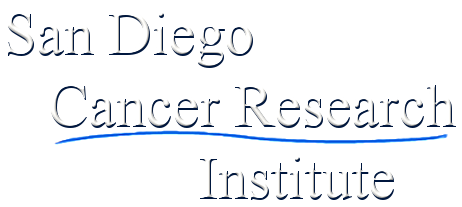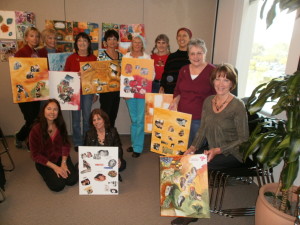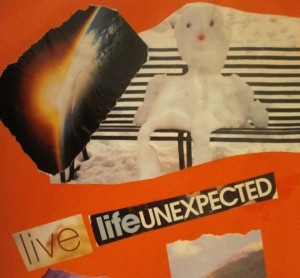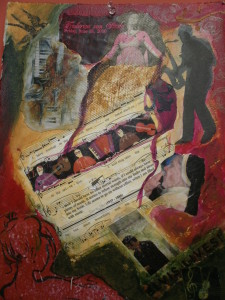On this page we have the Featured Articles from the years 2014 to 2016. Enjoy!
Return to current Featured Articles here.
Contributing Writer’s Archive 2017-2018
Hope Made Visible Project Update! by Alessandra Colfi, posted on December 1st, 2016
There is No Magic Pill for Burnout by Jimena Galfaso, MD, posted on November 1st, 2016
What is Yoga Therapy by Monique Lonner, Yoga Therapist, posted on October 2nd, 2016
The Life of a Therapy Dog by Isabella Polley, posted on September 1st, 2016
Fusion of Integrative Methods of Healing by Blanca Noel, posted on August 1st, 2016
Bone Broth by Kim Taylor, DAOM, L.Ac., posted on July 1st, 2016
From Tennis Player to Caregiver by Suzi Martel, posted on June 1st, 2016
Your Complete Guide to Mastering Healthy Eating on a Budget by Chef Jessica Leibovich, posted on April 1st, 2016
Tapas Acupressure Technique by Chris Lewis, PA-C, posted on April 1st, 2016
Cancer Treatment, Cancer Survivors, and Lymphedema: the Truth About Your Risksby Dana Wylie, posted on March 2nd, 2016
QiGong for Cancer Treatment and Recovery by Fay McGrew, posted on February 1st, 2016
SDCRI’s 2015, Year in Review, by Dr. Daniel Vicario, posted on December 31st, 2015
The Benefits of Gentle Yoga for Cancer Patients, by Justine Shelton,
posted on October 1st, 2015
The Feldenkrais Method®: Improving Function Through Awareness, by Anita Noone,
posted on September 1st, 2015
How Does Acupuncture Benefit People with Cancer?, by John Chang,
posted on August 1st, 2015
The Benefits of Mindful Meditation During & After Cancer Treatment, by Erin Graves,
posted on July 1st, 2015
Unlocking the Mysteries of Oncology Massage, by Teri Polley-Michea,
posted on June 1st, 2015
Exercise and Cancer Survivors, by Deborah Pomeranz,
posted on May 5th, 2015
Sound Healing, by Janice Motley, posted on April 2nd, 2015
What Is Healing, by Shamini Jain, posted March 1st, 2015
Energetic Bodywork and Reiki, by Todd Sargeant, posted February 7th, 2015
PhotoPainting, by Alessandra Colfi, posted on December 18th, 2014
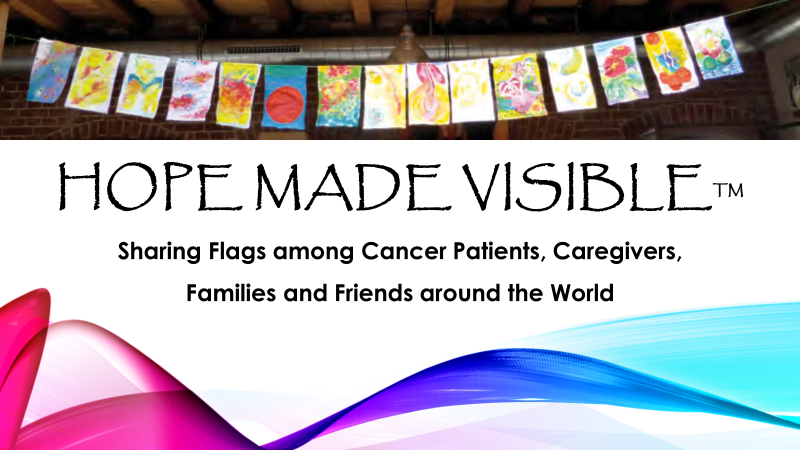
Our international, educational initiative started 4 years ago, inspired by the Nepalese and Tibetan flags, which symbolically bring healing blessings across lands, mountains, and reach out to distant communities.
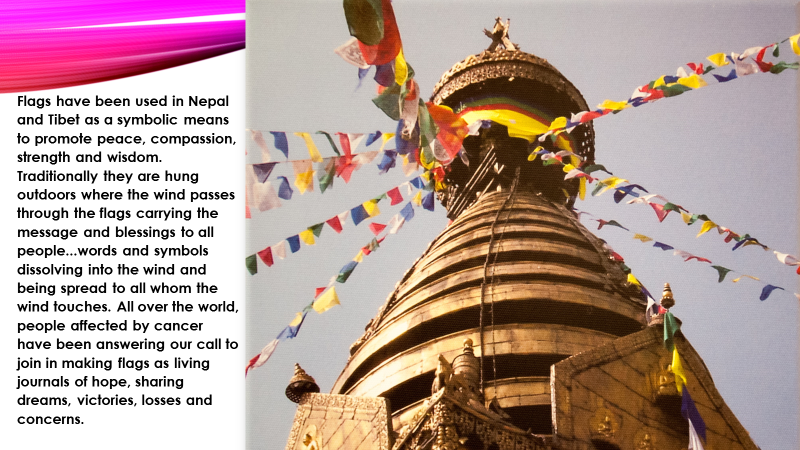
It’s been very inspiring and rewarding to follow the developments of this initiative, with many opportunities to share and build a virtual community based on local and non-local healing, aimed at fostering empathy and resilience among cancer patients.
Local workshops have been periodically offered through our Expressive Arts Therapist Alessandra Colfi and her programs. Sharp Healthcare was one of the first local group to join in. Currently a new series is being offered at UC San Diego Moores Cancer Center, followed by a series at UC San Diego Cancer Center in Encinitas in 2017.
Cancer patients have been engaged in guided relaxation, visualization, hands-on art making processes to create personal flags made mostly with fabric, paint, trims, quotes or personal messages.
Data have been collected in the form of narratives, patients’ feedback, and self-assessment / self-reporting tools, which Alessandra administers as surveys at the beginning and at the end of each 8-week segment for local groups; the principal tool is the Connor-Davidson Resilience Scale of 25 items (CD-RISC), created by Jonathan R. T. Davidson, M.D. and Kathryn M. Connor, M.D of Duke University, to assess depression and distress symptoms, post-traumatic stress disorder (PTSD), and patients’ resilience.
CD-RISC surveys show improvements of 6 to 20 points over 100, showing reduction in various pain and anxiety symptoms, in patients’ confidence in coping with the disease and in managing stress.
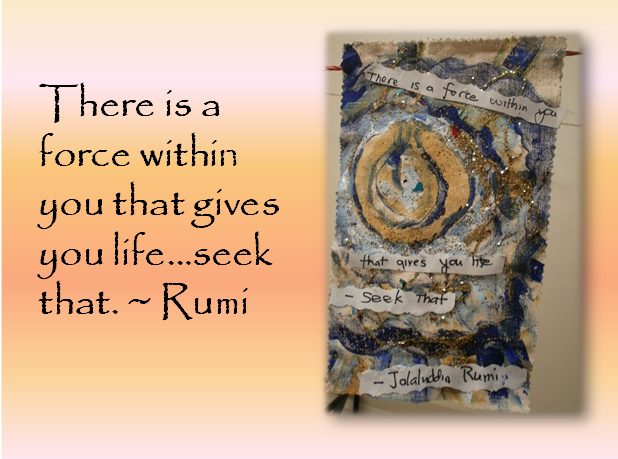
Participants’ feedback shows improvements in fostering empathy and their resilience by making and sharing flags. Expressions of patients’ feelings and emotions onto flags become catalysts for symbolic understanding and transformation.
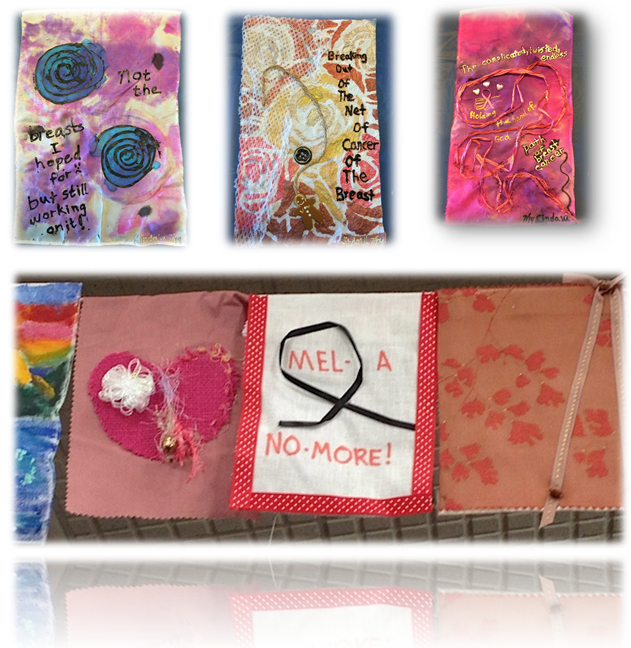
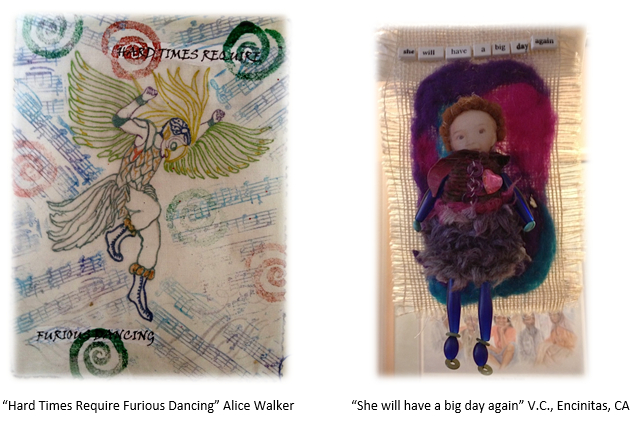
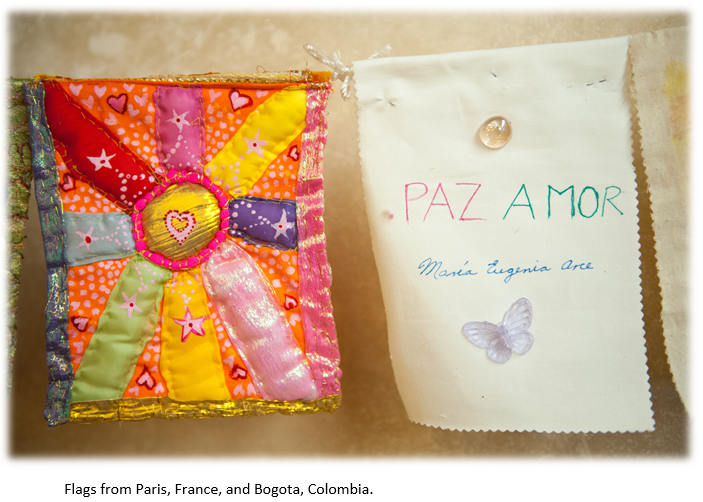
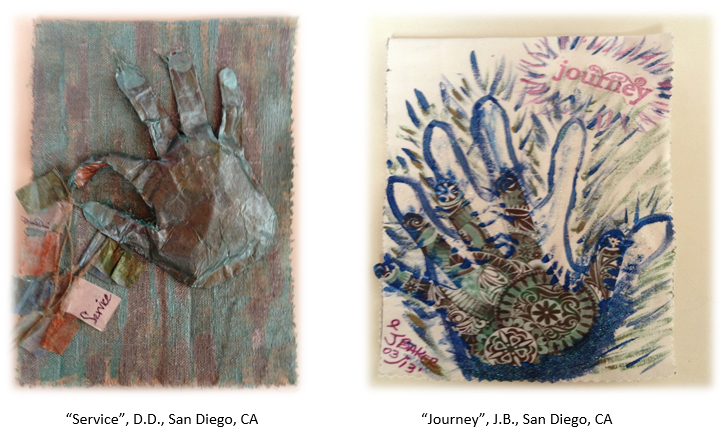
The call to join in and sharing their cancer journeys through art flags has been answered by groups, individuals, and families; for example, MACMA, a Breast Cancer Support Group in Buenos Aires, Argentina, dedicated several sessions to create flags together and sent them all to us.
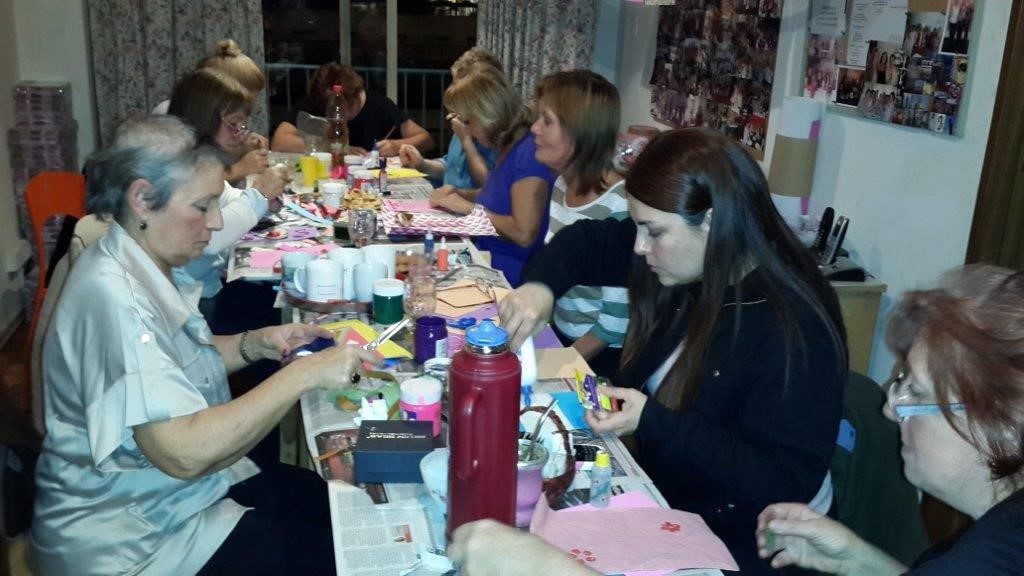
It was very meaningful and exciting when in February 2015 Alicia Galdeano, who runs MACMA, visited our Hope Made Visible™ exhibition at Front Porch Gallery in Carlsbad.
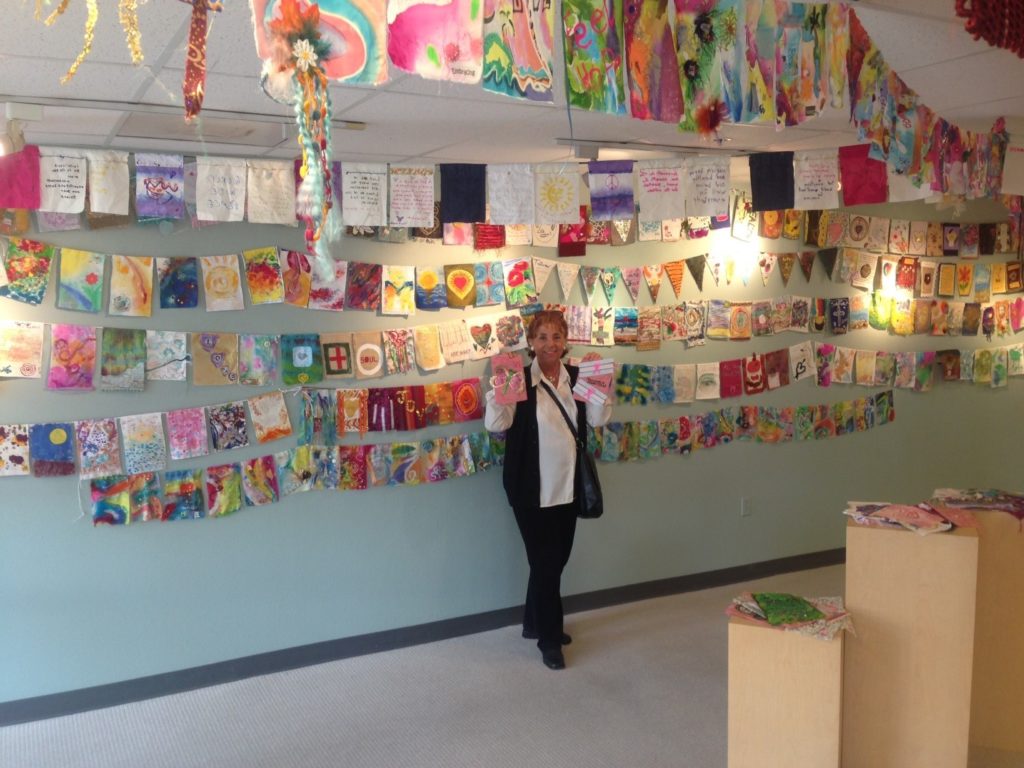
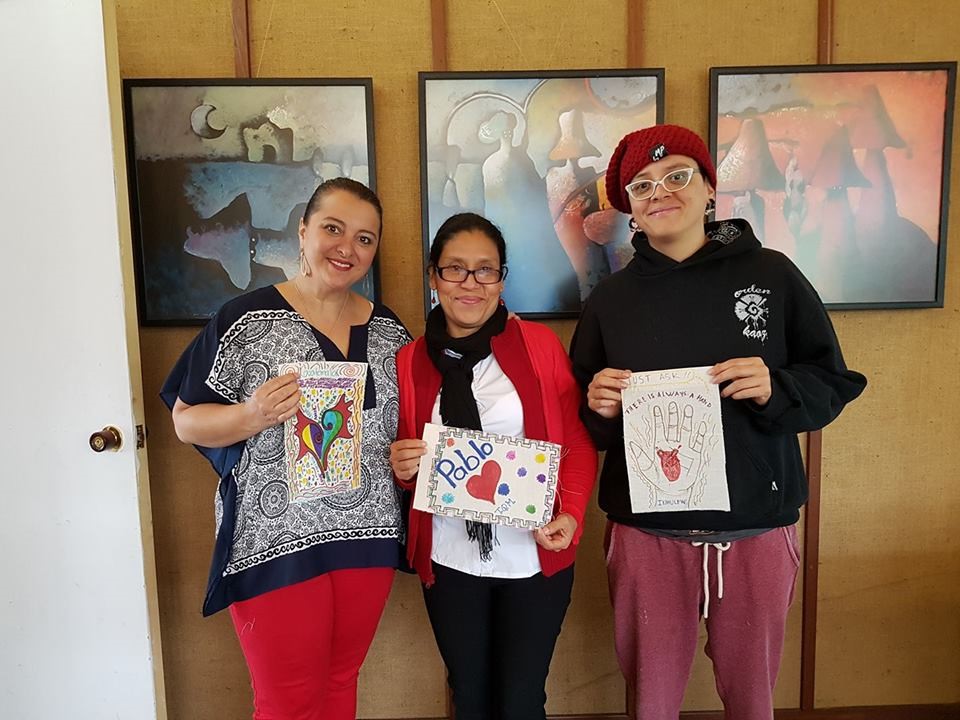
In Guatemala, Art Therapist Paulina Buonafina engaged patients at INCAN, oncology hospital in Guatemala City, making a long string of flags to add to our collection very early on. This year she embraced Hope Made Visible™ on her own, offering several workshops in the community to create flags; she plans to host a public installation with all the flags in March 2017. Another exciting development to look forward to! www.arteterapiaguatemala.com
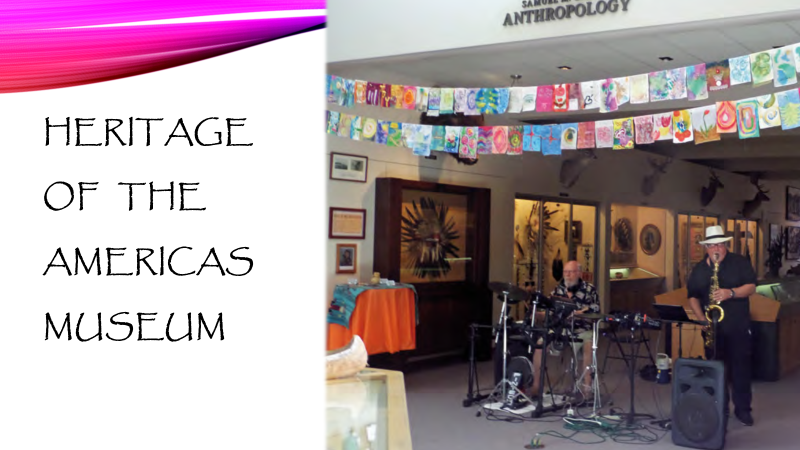
In 2014, San Diego Cancer Research Institute received the invitation to exhibit Hope Made Visible™ and all artwork made by patients, at the Heritage of the Americas Museum, at Cuyamaca College in San Diego. The whole community of patients, families and practitioners came together to celebrate the healing spirit and the dedication of all the artists, and to remember those who live on in our hearts.
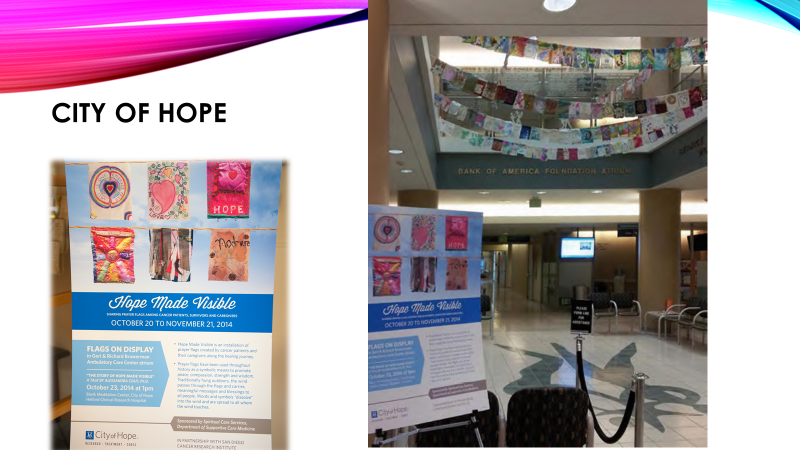
City of Hope requested a presentation and a training for some of their Social Workers, Chaplains, and Nurses so that they could engage their patients in creating flags; at the same time, all the flags were featured in the Atrium at the Outpatient Clinic during Spiritual Care Week in October 2014. The impact was so remarkable that City of Hope then requested to keep the flags on display for the whole month.
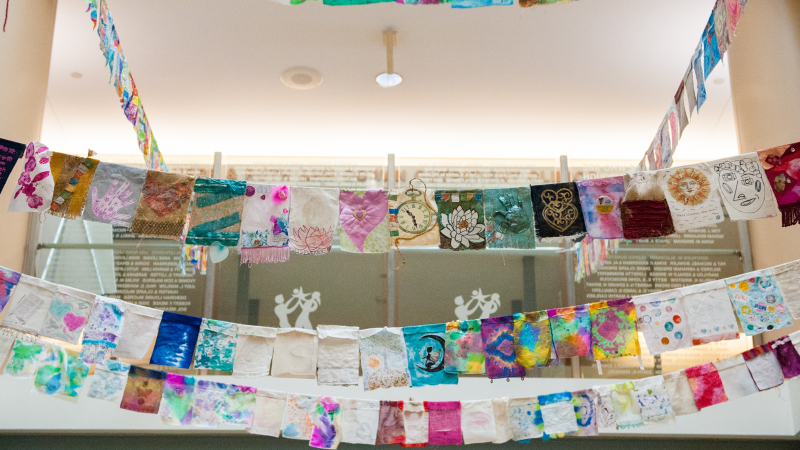
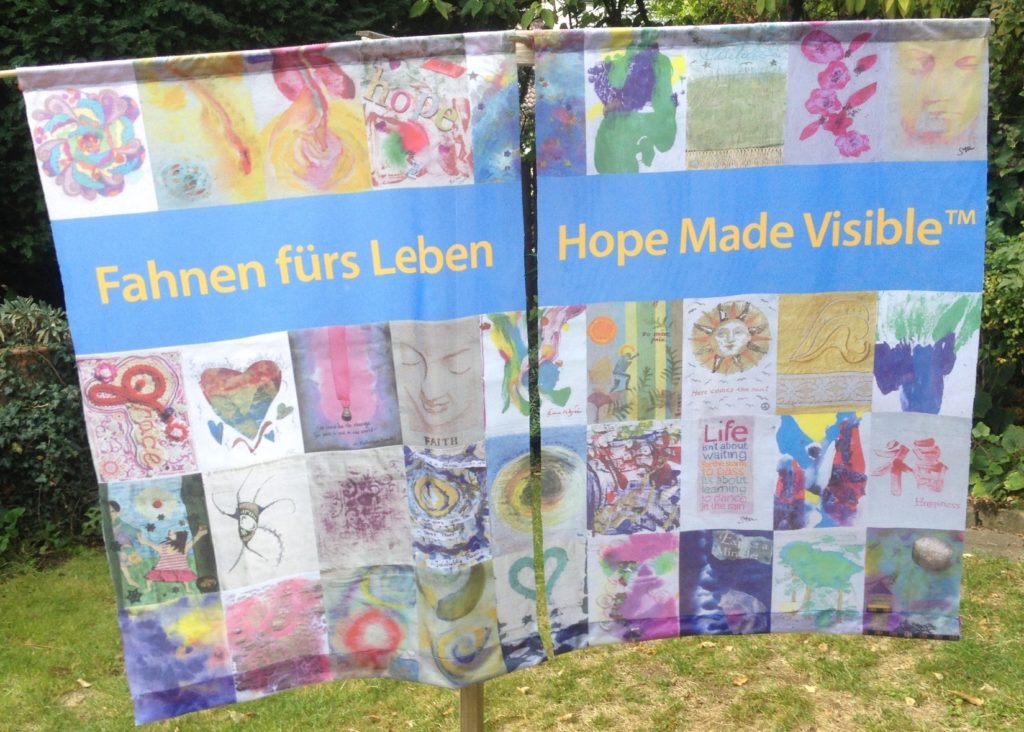
At the same time, in Germany, Gabriele Heyd combined flag-making workshops with outreach, marketing, and PR to share “Fahnen furs Leben” (Flags for Life) across the Country, exhibiting at a variety of venues, including a Rehab Conference in Karlsruhe in April 2015.
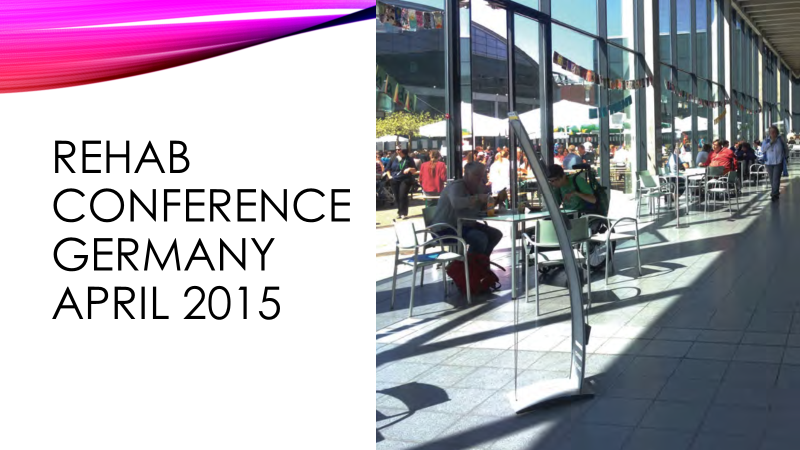
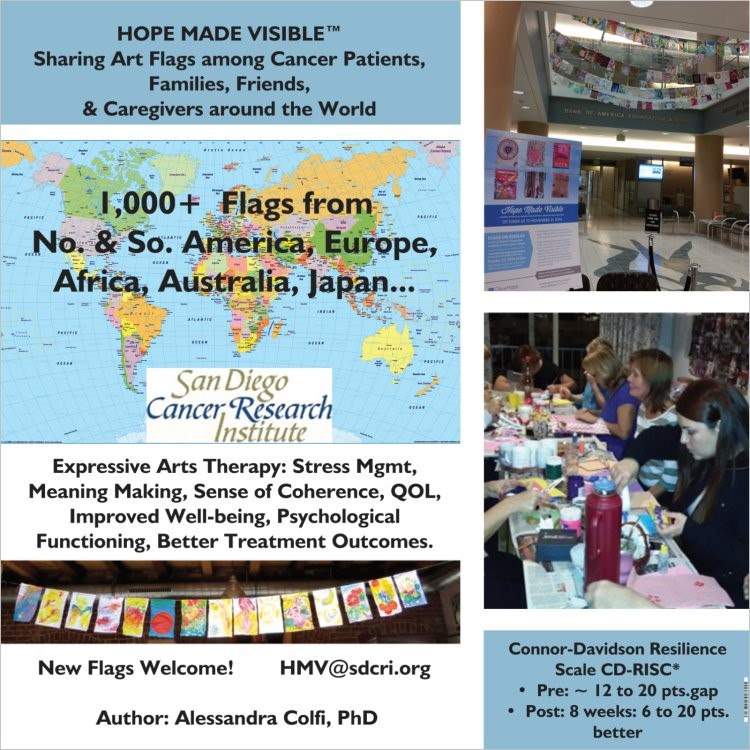
In March 2016 Hope Made Visible™ flags have been displayed at the American Psychosocial Oncology Society Conference – www.APOS-Society.org , and featured as an exhibition booth and as research poster. The only art program at the conference!
In July and August 2016, the full display of flags provided a symbolic canopy at Oceanside Public Library, adding another layer of patients’ satisfaction, pride, and feeling connected beyond cancer. It’s been especially meaningful and timely for the library staff who lost 2 of their own members to cancer this year.
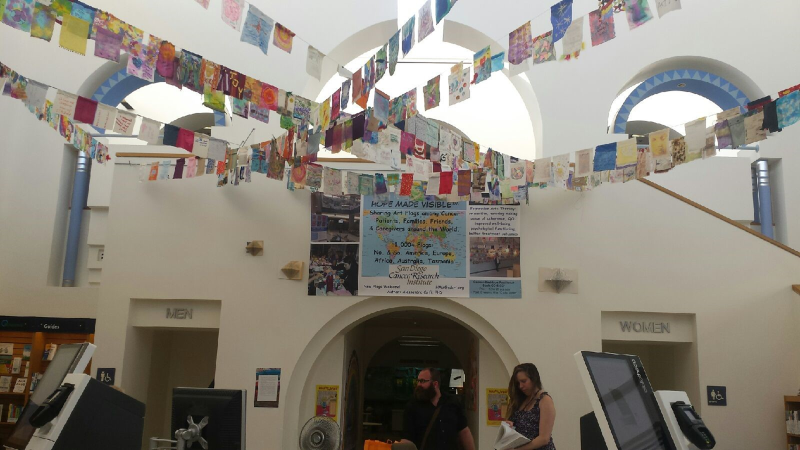
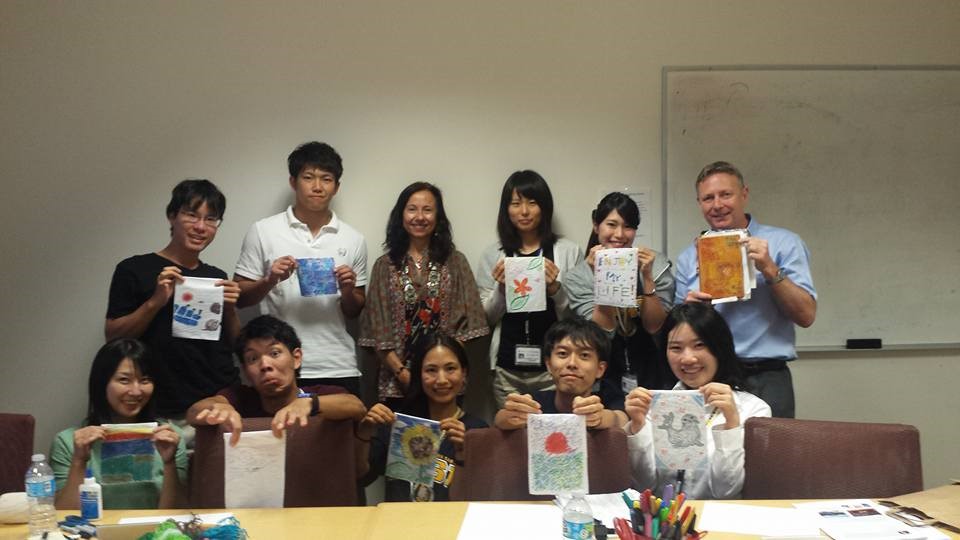
Last September Alessandra presented Hope Made Visible™ to medical school students from Dokkyo University (Japan), on a week-long visit at UC San Diego Moores Cancer Center. Together they took the opportunity to learn about mind-body-spirit modalities available to support oncology patients and their families, and to make their own flags to take back to Japan to inspire colleagues and other clinicians to join in the global initiative.
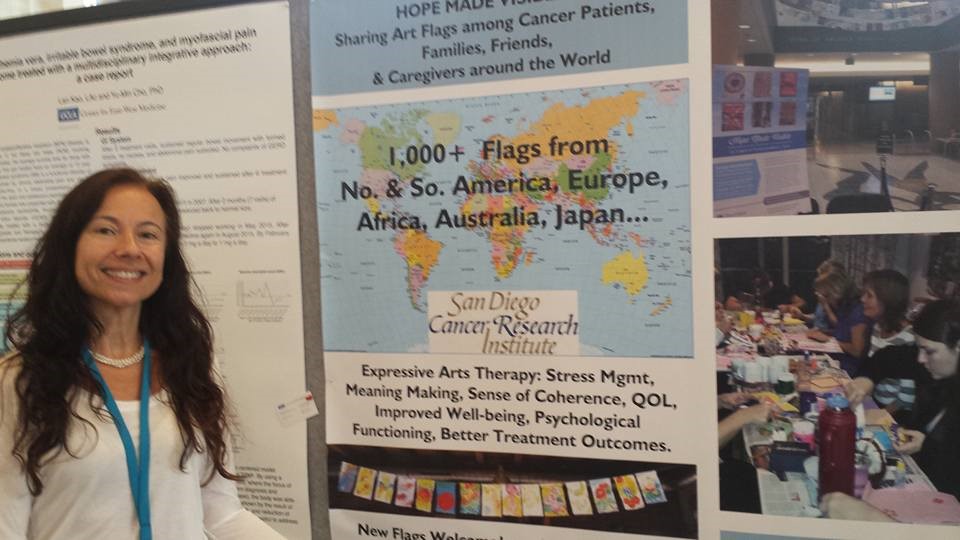
Hope Made Visible™ poster was also entered in a competition at the Academy of Integrative Health & Medicine Conference “People, Planet, Purpose” – www.AIHM.org – this past October in San Diego. On November 4th, the last day of the conference, Alessandra shared about her Expressive Arts Therapy program including Hope Made Visible™ at the Consciousness and Healing Initiative Summit: The Healing (R)Evolution – www.CHI.is.
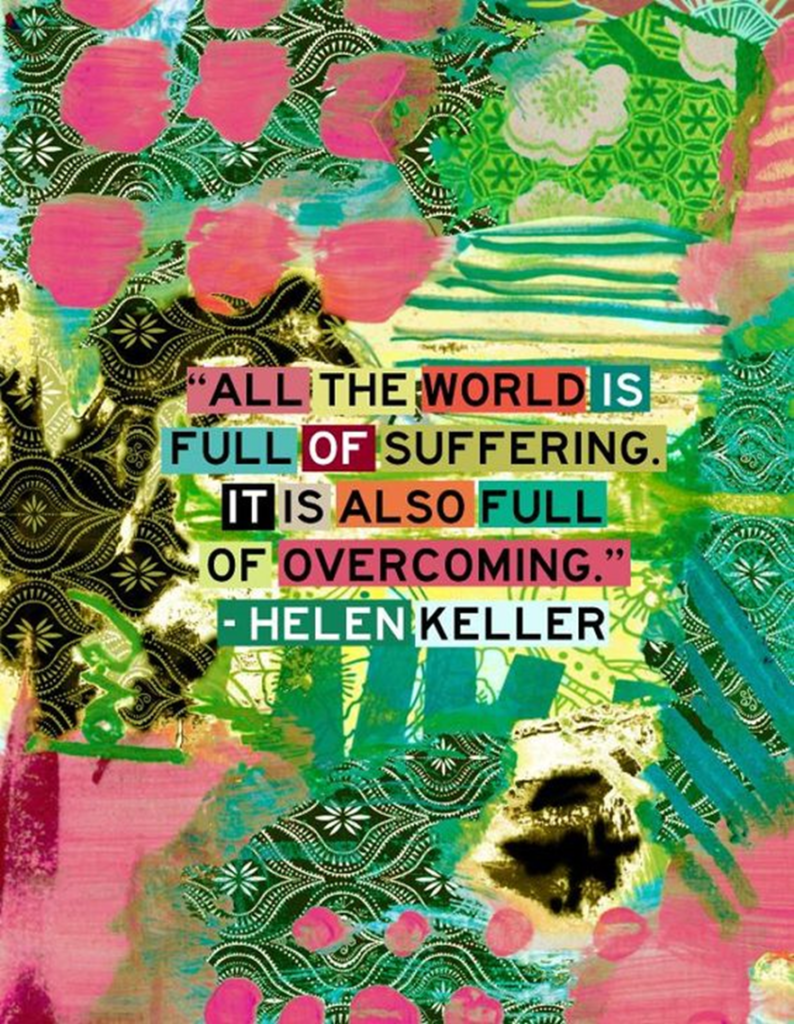 Alessandra has just completed a 2-year program at Habitat for Humanity; Hope Made Visible was well received by Veterans experiencing homelessness, addictions, PTSD. “Thank you so much Alessandra! Your work with our veterans has been magnificent and deeply appreciated. “ (Donna Deutchman, CEO, Habitat for Humanity SF/SCV).
Alessandra has just completed a 2-year program at Habitat for Humanity; Hope Made Visible was well received by Veterans experiencing homelessness, addictions, PTSD. “Thank you so much Alessandra! Your work with our veterans has been magnificent and deeply appreciated. “ (Donna Deutchman, CEO, Habitat for Humanity SF/SCV).
The invitation to create and gather flags is always open and encouraged, as well as considerations for exhibitions locally and internationally. More than 1,000 have been collected so far, all unique in their symbolic expressions of hope, healing, challenges, sorrows, joy, and resilience.
Hope Made Visible™ – Part II: Research Studies
The use of Art for healing is well documented and supported by positive impact on the health and quality of life of oncology and other patients. Besides the data already collected, there could be interesting opportunities for further research; studies would be desirable on multiple fronts:
1-Simple, low-cost tests to evaluate distress and anxiety in patients and their caregivers are necessary to identify and implement early intervention. Distress Screening has become mandatory in cancer care since 2015.
Biofeedback screening such as BioWell http://www.bio-well.com/ could be used in a study to identify, monitor, and evaluate patients’ energy, stress, and vitals.
2- Is ‘a sense of coherence’ what makes the difference in boosting patients’ resilience?
Often patients seek complementary modalities on their own and after several months of their initial diagnosis. In an integrated model of care patients can safely access complimentary modalities.
Clinicians often note higher cooperation by patients who are engaged in supportive complementary modalities like Expressive Arts Therapy.
Clinicians often report fewer pain medications prescribed and fewer visits to those same patients, thus reducing costs and increasing capacity.
3- Is art making a catalyst for lower inflammatory response in the body?
The effect of mindfulness on inflammatory health was shown in a study by David Creswell, PhD, published in February this year. This research showed changes in brain circuitry and reduced inflammation after three days of mindfulness training, while three days of relaxation did not have the same effect. Creswell explains the difference in impact between mindfulness meditation and relaxation:
“We show that mindfulness meditation impacts measurable brain circuits more so than helpful relaxation practices, and that these brain circuit changes help us understand how mindfulness meditation improves health. Mindfulness teaches participants how to be more open and attentive to their experiences, even difficult ones. By contrast, relaxation approaches are good in the moment for making the body feel relaxed, but… harder to translate when you’re dealing with difficult stressors in your life. This new work sheds light into what mindfulness training is doing to the brain to produce these inflammatory health benefits.” (Creswell, 2016, Carnegie Mellon University)
Follow news about HMV and more on the Expressive ARTS Therapy Facebook page!
There is No Magic Pill for Burnout
by Jimena Galfaso, MD
Introduction to article:
When this article, There is No Magic Pill for Burnout, was shared with me by Dr. Vicario, I realized how the subject is not unique to just one group. The burnout that Dr. Jimena Galfaso so beautifully describes also effects volunteers, healers, therapists, caregivers & patients.
Read the article to find out how to “make deposits in our wellbeing bank account, nourish our bodies, minds and souls”.
~Mary Hollander
As we all know, there is no magic pill to prevent or treat burnout. If there were, many in the healthcare professions, including most physicians and nurses would be taking them. Unfortunately, the current setup of the medical system leads many practitioners to suffer from burnout for years, which is frequently associated with alcoholism and drug abuse, and can result in them leaving their profession or even committing suicide. We are all aware of this paradox, where we take care of patients’ health, but are not as good at taking care of our own. As a physician myself, I suffered from burnout for many years before I realized there was something I could do about it.
Not only is there no magic pill, but there is no formula either. There are, however, ways to start paying attention to our own health in order to prevent burnout or treat it if we’re already suffering from it. Most practitioners in healthcare are deeply committed to offering high quality service to their patients. Yet we all know that when we’re exhausted, depressed, irritable or numb we cannot provide the best
care to those who we have pledged to serve.
Burnout is caused by an imbalance between what “comes in” and what “goes out”. As healthcare practitioners we give, give and then give some more. Most of us work long hours in environments that are stressful, and where we are faced with others’ suffering almost constantly. Often, our tendency is simply to go numb and keep going, until one day we collapse, or we quit, or our partner leaves us, or we get sick. That is often what it takes for us to start paying attention. But what if we can prevent this from happening and create a practice that is fulfilling, satisfying, meaningful and that makes us feel recharged and enlivened?
I am not going to lie to you: it’s not going to happen overnight. But it can be done, if you are committed to your own wellbeing, and that of those around you. It’s important to remember that burnout not only affects us. It also affects our loved ones, our patients and our colleagues. We’re social animals and we are constantly attuning to each other. Research shows that when two people (or more) are emotionally attuned, they have the similar brain waves in an EEG. So if we’re burned out, we cannot help but pass this on to those around us, like ripples in a pond.
In order to address this imbalance between the “giving and receiving”, we need to look at the different dimensions of our humanity: physical, emotional, mental, spiritual, and social. An important question is: what nourishes us, in each of these dimensions? We need to fill the “wellbeing bank account” before we keep withdrawing funds, and most of us have been in red for quite a while already.
What nourishes you at the physical level? What foods, what kind of exercise? Do you get enough touch and physical contact? Do you get enough sleep? Enough rest during the day? What are your recharging and restoring routines?
At the emotional level: are you in touch with your emotions? Do you know how to process them so they can move through your system and not get stuck so that you have to numb yourself or repress them in order to function? Emotions are powerful information about what is happening and they are crucial when it comes to making decisions. Instead of fearing “being emotional”, we can learn to feel our emotions without allowing them to control us. They allow us to be more connected with ourselves and with others, to create more meaningful relationships – with loved ones, colleagues and patients, which in turn nourishes us and recharges us.
At the mental level, are you having significant and meaningful conversations, so that you feel inspired and are open to learning? Do you take the time to read what interests you?
Do you have relationships that nourish your heart and soul? Do you have a support system that you can rely on when you need it? Do you make time to spend with your loved ones and to make meaningful connections? Do you have the skills and tools to manage the relationships that are challenging?
Do you have a spiritual connection or practice that nourishes your soul? Do you feel aligned with a higher purpose, call it God, Mystery, Universe, or whatever you like to call It? Do you feel held by the unknowable, or do you feel alone and isolated, wondering what this is all about?
These are some of the questions that we can consider, to start making deposits in our wellbeing bank account, nourishing our bodies, minds and souls. It might feel overwhelming to consider all these questions at once. My invitation is to pick one or two, and start taking baby steps in the right direction. One of my favorite practices that has helped me tremendously in my own healing process is appreciation and gratitude. Research has shown that focusing on gratitude not only increases people’s personal wellbeing but it also improves their health.
Just like when one of your patients has terrible habits, you can’t ask them to change their diet, exercise daily and get a less stressful job all in one month, you probably can’t do that either. But if they were to eat just one more vegetable every day, imagine how different they might feel in 2 months. It might give them the extra energy to walk up their office stairs each morning instead of taking the elevator. After a few months of that, they may even feel up to walking a mile on the weekend. And then their sleep would improve. And then their cortisol levels would drop a bit. And they wouldn’t crave as much sugar. Imagine how this might continue to unfold over 12 months… and the only thing they needed to think about was adding one vegetable per day.
Similarly, what (seemingly small) action step can you take today? Maybe adding that extra vegetable, or going to bed 15 minutes earlier, instead of checking your email or Facebook right before you go to bed. Or maybe you can take a few minutes each night to think what you feel grateful for. Or tell your partner, child, colleague or friend something you appreciate about them. Again, start small. Start with changing one habit at a time, and allow that to build over time. After a while, it gets easier.
When we sacrifice our health for our calling, everyone loses. The best way to help others is to help yourself first, so that you can keep serving in a way that is sustainable and even joyful. Everyone that you touch will benefit from your investment.
What is Yoga Therapy
and 3 important ways it helps cancer patients heal.
By Monique Lonner, Yoga Therapist
Yoga Therapy is a 4,000 year old complimentary healing modality that uses gentle body movement, breathing techniques and progressive relaxation practices to bring all the body systems into a synchronistic bio-rhythm that has been proven to engender healing.
Science has recently taken a good hard look at the healing properties of yoga in regard to many different conditions. Back pain, anxiety, depression heart disease and cancer are all areas in which therapeutic yoga has been proven to be healing and curative.
In medically published studies cancer patients who participated in therapeutic yoga practice on an on-going basis reported less anxiety and depression, lessened fatigue, improved sleep, improved physical strength, decreased treatment side effects, a favorable immune response, decreased DNA damage at the end of radiotherapy, more favorable post operative outcomes, physical and mental invigoration, empowerment and improved coping skills.
If this kind of complimentary medicine came in a pill form we’d probably line up to take it!
Why is yoga so helpful on the path of cancer recovery? There are a myriad of reasons, some known, some are still not completely understood. Let’s take a look at 3 top reasons why yoga therapy is a wonderful complimentary modality to cancer treatment and recovery.
1. Stress reduction
Stress has been scientifically proven to decrease immunity and increase inflammation.
Immunity cells help control malignant cells as they form in the body. Prolonged stress can diminish the immune system response to cancer cells because when we are stressed our immune system is busy looking outward for the imminent danger – like a tiger – rather than looking inside for a cancer or virus. It’s as if immune system prioritizes to help us escape and recover from the tiger attack first, then tend to the inner terrain second.
In preparation for the tiger attack the body is sending more blood flow to the arms and legs to prepare to run or fight and shunting it off from the organs and other non immediately necessary systems, including hormones, digestion and reproduction.
It also is readying the body with global inflammation which will help to heal cuts and tears should we be bitten and scratched.
This is great – if we’re being attacked by a tiger. But generally our everyday stress has little to do with a life-threatening animal attack. Because many of us are under constant stress this imbalance of our immune, circulatory, digestive, reproductive and hormonal systems has become chronic and can be fertile ground for cancer to form and flourish.
In recent years inflammation has come under medical scrutiny for its unique role in supporting the growth of cancerous tumors. One of the most important things that therapeutic yoga practice offers cancer patients is the “Relaxation Response”. This physiological state of harmony reverses the stress response. It stops the production of hormones and chemicals in the body that produce inflammation, reduces muscular tension and pain levels, returns blood flow to the organs and balances the body systems. Importantly it also bolsters the right kind of immune response helping the body to better fight the cancer cells.
2. Increased circulation
The heart pumps about 2,000 gallons of blood a day through 60,000 miles of blood vessels which weave throughout muscle tissue, organs and bones. The blood is the body’s delivery system of oxygen and nutrients to all the cells. When fatigue makes us more sedentary and the muscles get painful and stiff the tightness can make it harder for the heart to pump blood to all the areas that need nourishment.
The lack of oxygen and nutrients increases the fatigue and pain levels and the body gets even stiffer in a vicious circle.
Therapeutic yoga practice moves every joint with gentle motion. This helps to engender greater blood flow to the bodily tissues which in turn provides greater oxygenation and nourishment to the cells. When the cells are nourished they feel better and heal better. Adding even the gentlest amount of movement, like wiggling fingers and rotating wrists and ankles helps increase circulation.
Movement also provides relief for the heart muscle. Skeletal muscular movement acts as second pump for the circulatory system and takes pressure off the heart; this can reduce the incidence of heart disease and reduce fatigue. When movement is coordinated with breathing, as it is in yoga practice, the body finds a more harmonious bio-rhythm heightening these results.
Both the yogic and Chinese forms for complimentary medicine ascribe to the theory that stuck and stagnant life force in the body (Prana and Qi respectively) can contribute to disease and moving that life force, through yoga, qi gong and acupuncture, can facilitate healing on a very deep and profound level.
3. Lymph drainage
If the circulatory system is the main food delivery system for the cells, the lymphatic system is largely the clean up crew. The body has a large system of lymphatic vessels and lymph nodes. Within the system flows a clear watery fluid called lymph. These are all part of the body’s immune system and play a big role in fighting invaders, filtering out unwanted cells and riding the body of toxins. Since cancer treatment involves ingesting a large amount of necessary toxins a healthy lymphatic system is very beneficial to the healing process.
Unlike the circulatory system the lymphatic system has no pump of its own. Muscular movement is necessary for the movement of the lymph fluid. Stuck lymph fluid means stuck toxins in the body and can create swelling of the lymph nodes and ultimately a condition called lymphodema.
Yoga practice offers specific movements and poses which help move the lymph fluid and support a healthy immune system.
According to yogic philosophy moving toxins out of the body is even more important than bringing nutrients in. The belief is that if the body is filled with toxins then the life force becomes blocked and stagnant allowing disease to ensue. Yoga movements help remove the toxins so the life force can move freely. Then there is room for nutrients to enter and healing can occur.
These are only three of the great benefits that yoga therapy can provide someone going through cancer treatment and recovery. New studies examining how yoga therapy can aid the body in healing and preventing disease are regularly conducted and published.
As a Yoga Therapist I am always encouraged by these new studies but I am never surprised by their positive findings. Yoga wouldn’t have lasted 4,000 years if it didn’t work!
The Life of a Therapy Dog
by Isabella with a little help from my handler mom, Teri

Isabella, in full regalia
I’m Isabella. I am a Love on a Leash therapy dog. My mom says I am love and joy all tangled up on one leash.
Pet therapy is not new, it has been around for quite some time. Even Florence Nightingale wrote about the animal human relationship, and our ability to heal each other. Like you scratch my back and I’ll scratch yours.
It’s a tough job being a therapy dog but someone has to do it.
You would think it would be easy to be cute, to attract attention, to make people smile and feel better. Well, it’s not THAT easy. It was a commitment and challenge that I was up for!
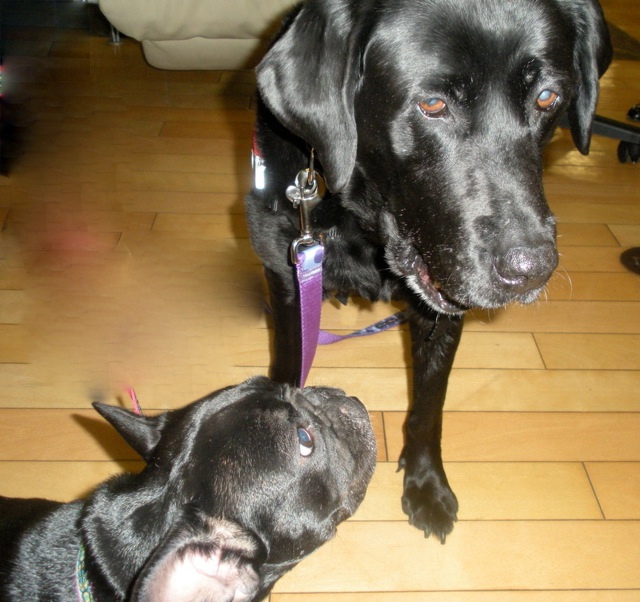
Isabella and her best friend Gracey, a fellow Therapy Dog
We train!
We have to follow some rules!
First we have to be potty trained. Make no mistake, they do not want us marking up the clinic!
Then we go to school. It’s called Canine Good Citizen Training. We learn to SIT, LAY DOWN, SHAKE, STAY–I almost flunked right there. We have to sit and stay for 2 whole minutes, I felt 1 minute 45 seconds was sufficient. We couldn’t even move if there was a lot of commotion, not even to check things out. We had to learn LEAVE IT, just in case there was a pill or something on the floor we may pick up and eat. I’m pretty close to the floor so LEAVE IT was an important command for me to learn.
I had to learn that I couldn’t jump up on you and absolutely no kissing.
What I say, I’m a Frenchie, and they named French kissing after me! How can I earn your love and affection without a kiss?
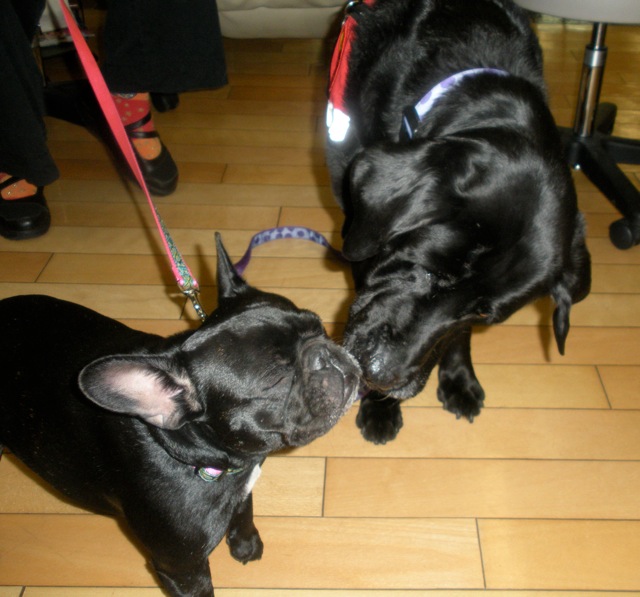
Gracey shares the love with Isabella
Not only do we have to be well behaved we have to take weekly baths and get shots! That’s tough! We don’t want to bring you any germs that might make you sick.
There is real science that supports the use of therapy dogs like me in the clinical setting. You and I know it’s just more fun hanging out with a dog but now there is scientific proof!
A nurse at the University of Missouri College of Veterinary Medicine heads up the research on Animal and Human interaction, they have found that hanging out with animals can increase one of the humans hormone levels called oxytocin. She says oxytocin is a feel good hormone and when we feel good we are more trusting. 1
I love people and people love me! I love the patients, staff, even the other therapy dogs.
Did you know people who have dogs heal faster? No kidding! There is research that proves that too! Research shows that pet therapy programs help patients heal faster, and decrease anxiety and stress. No surprise to me, remember I’m a therapy dog.
According to NPR, (National Public Radio) If you pet me your blood pressure can go down. I can help you live longer by taking you out for a walk. By just interacting with me, your body heals itself. 2
Researchers have found that patients have reported decreased pain and measured decreased catecholamines which are released during the body’s stress response, along with a increase in the endorphins—that’s the feel good hormones after a visit by a therapy dog. 3
The National Institute of Health has done studies on therapy dogs and their people. We MUST be an important part of the healthcare team if the government is interested in researching things about us.
I can reduce your stress and anxiety and help you never feel alone. 2 You don’t have to limit yourself to visits with me, cats are pretty good too but don’t tell the other dogs I said that. All pets give unconditional love. We love you, you feel better and you get better fast.
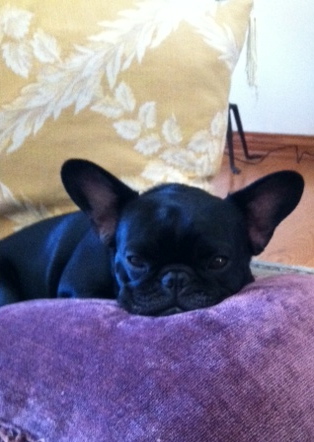
Article writing is a tiresome job for Isabella
Now where are the cookies?
1. Pet Therapy: How Animals And Humans Heal Each Other, Email, March 5, 20123:44 AM ET, Heard on Morning Edition, JULIE ROVNER NPR
2. Hajar, R. (2015). Animal-Assisted Therapy. Heart Views : The Official Journal of the Gulf Heart Association, 16(2), 70–71
3. Curr Pain Headache Rep. 2013 Apr;17(4) The science behind animal-assisted therapy. Marcus DA1.
Bio:
Teri Polley-Michea is a RN/Massage Therapist, Energy worker, a volunteer for Love on a Leash, Girl Friends Care, and North County Cancer Fitness. As a nurse massage therapist she specializes in oncology massage and massage for clients with complicated medical histories. She incorporates Reiki, and Healing touch into her healing sessions. Teri teaches oncology massage and medical massage courses at several local massage schools and privately. Teri has worked with UCSD’s Center for Integrative Medicine as a Massage Therapist, Director of Massage, and Massage Program Manager. Teri is in private practice full time in Carlsbad, Ca. Isabella meets and greets all of her massage clients.
More about Isabella mom, Teri Polley
Back to the top.
FUSION OF INTEGRATIVE METHODS OF HEALING
CRANIO SACRAL – HEALING STONES -SOUND – COLORS AND FLOWERS
by Blanca Noel
As human beings gifted with the powers of assimilation, we travel in and out of dimensions interwoven in a present of activity and stillness, sound and silence, light and darkness, participation and stagnation, desire and indifference, connection and disconnection, ability an inability, joy and sadness, health and unhealthiness, freedom and oppression, relaxation and stress and many more steps in the staircase of life.
Due to natural conflicts and disruptions of daily living, a deterioration in the human alignment begins to take place, causing a variety of malfunctions of the self that will eventually be manifested in a woven web of energetic entanglements, that will create unhealthy situations requiring intervention.
It is precisely at this point, when skilled integrative methods of healing become essential in the process of regeneration or reintegration.
CranioSacral therapy with its subtle management of the spinal fluid, promotes thru the pathways of nerves, vessels, muscles, bones, organs and lymphatic regions a dramatic embodiment of optimum well-being. Forming a bridge of energy between patient/client that clears and cleanses the impurities that have produced cell changes and dysfunctions.
When the use of Semiprecious Healing Stones is added to CST ( CranioSacral Therapy ), the process of well-being moves a step higher, healing stones are the flowers of the center of the earth, that thru millions of years have encapsulated the planetary energy that can be transmitted during a therapeutic procedure.
The special stones are applied in different areas of the body in accordance to the needs of the individual, the stones different vibrational rates and ranges will accelerate the healing process. Not all stones are created equal, some have the ability to heal and others are objects of beauty.
The stone color, size, weight, brilliance, translucency and opaqueness, have much to do in the effectiveness of treatment. The therapist, the stones and the client/patient become interconnected in waves of multidimensional healing.
The birthing places of the stones leave an electromagnetic imprint that ameliorates the physical, mental or emotional difficulties exhibited by the client/patient, such is the value of their proper use, they are perfect gifts from mother nature to alleviate human disorders.
Healing stones are not only place on the individual seeking comfort, but are also placed under the therapy table and in different areas of the therapy room.
Stone essences may also be made to promote further improvement.
Tibetan Healing bowls, bells, gongs, chimes and rain sticks, may be implemented as part of the healing method. As with the stones the bowls can be on or around the person, and may be played to soothe the soul by following the inner dialogue between the client/patient and the therapist.
Flower essence sprays may be used to unify all the techniques used during therapy, they are the dancing drops of joy and peace that wrap the session, allowing the person seeking assistance to go deeper into the dimension of optimum wellness.
Blanca Noel uses all the methods described above, and has been able to make of her practice a daily meditation, she communes with the celestial assistance and flows with the energy that surrounds us all. As an instrument, her hands assist in repairing energetic disruptions in the filaments of the aura. She enters into a silent soul dialogue with her clients, that has allowed her to develop the “Art of Soul Dialoguing”, taught by her in Encinitas and in Colombia.
Blanca’s web site is: www.blancanoel.com
Bone Broth
by Kim Taylor, DAOM, L.Ac.
Bone broth is by no means a recent trend. It is an ancient super food that is simple, delicious, and effective, and has been a mainstay among traditional cultures worldwide for thousands of years. If you have ever been satisfied by a comforting bowl of chicken soup when you have a cold, then you have already experienced this ancient wisdom. Science and tradition tell us that bone broth is very nourishing, but how nourishing will vary depending on the diet and lifestyle of the animal, how it is processed, and what other vegetables, herbs and spices are added to the broth (Fallon, 2014).
Cooking with bones is akin to cooking with the “roots” of the animal. Bones should be from locally sourced, grass-fed animals, and wild caught fish. Broth is then slow simmered with a touch of apple cider vinegar for many hours to maximize the extraction of amino acids and minerals. Because these parts of the animal often go to waste, this becomes a sustainable practice from an ethical and economical perspective. Bones are often less expensive than muscle and organ meats, and practically any vegetable scraps may be added to the broth for flavor and nutrients (Chen and Mojica, 2016). Medicinal herbs and spices may also be added to target specific health concerns. The savory, umami taste is derived from glutamates released during the simmering process, in similar concentrations to those found in breast milk, making a tasty bone broth the ultimate comfort food (Agostini, et al., 2000 as cited in Chen and Mojica, 2016).
In today’s world of growing epidemics of mental and physical illness, where people are regularly taking antibiotics and other pharmaceutical drugs, and where food is laced with chemicals unrecognizable to our bodies, an increasing number of people have damaged, abnormal gut flora dominated by pathogenic microbes (Boynton and Brackett, 2014). This results in the inability to nourish the body properly, and may produce toxins that absorb into the bloodstream and cause inflammation and disease (Chen and Mojica, 2016). Inflammation is linked to many types of diseases, including cancer, arthritis and other autoimmune conditions. Patients receiving chemotherapy are exceptionally vulnerable to stomach damage and leaky gut issues, loss of appetite and taste. Eating can feel like more of a chore than a pleasure, which may compromise nutrition and quality of life. In addition, with aging and poor health, the body loses some of its ability to repair connective tissue such as bone, tendon, ligament, cartilage, skin, hair and nails.
Bone broth is rich in collagen, cartilage, bone, and marrow, which are the building blocks needed to rebuild and rejuvenate. The highest concentration of iron is found in the marrow, and is responsible for the transport of oxygen and production of red blood cells. Marrow is prized as a sacred, energizing and regenerative food by native cultures around the world, and is the first part to be eaten, instinctively, by animals after a kill (Fallon, 2014). Marrow is the site of hematopoiesis, or the process by which stem cells produce the cellular components of all of the different blood cell types and tissues critical for survival. These include but are not limited to the erythrocytes (red blood cells) for oxygen transport and lymphocytes (white blood cells), including the natural killer (NK) cells, T cells, and B cells needed for a strong immune system. Today’s research on stem cells places marrow at the center of some of the most far reaching work of modern science, as well as to the center of the table in many of today’s fine restaurants. According to Anthony Bourdain, “If God made butter, it would taste exactly like bone marrow.”
Bone broth contains four key amino acids: Glutamine, glycine, proline and alanine. Glutamine is fundamental for rebuilding a gastrointestinal tract damaged by stress or illness. When combined with glycine, the body synthesizes glutathione, which is the body’s primary detoxifying antioxidant, so bone broth not only nourishes, but also detoxifies the body. Glycine facilitates the production of other amino acids involved in many bodily functions, such as building blood, aiding in the production of glucose, enhancing gastric acid secretion, assisting in wound healing, and detoxification of the liver (Chen and Mojica, 2016). Healthy people should not be deficient in glycine, but during stress, illness or exposure to toxins, the body may not synthesize sufficient amounts. Proline and glycine are the building blocks of cartilage and collagen, responsible for healthy joints and skin. Proline is found in virtually all animal and plant proteins, so deficiency should be rare. However individuals not eating enough protein, either from a high carbohydrate, low protein, low fat or vegan diet may be lacking. Common sense tells us that millions of people suffering from stiff joints, skin diseases and other diseases related to cartilage and connective tissue, may not be healthy enough to manufacture sufficient amounts of proline and glycine (Fallon, 2014). Alanine assists in liver function and glucose metabolism. Bone matrix also provides other trace minerals such as boron, phosphorus, calcium and magnesium, necessary for nerve transmission, gland function, and healthy bones and muscles.
The wonderful thing about preparing bone broth is that it leads to so many delicious dishes, and with a bit of practice, anyone can have broth on hand at all times. The goal to making a good broth is to make sure it sets up as a solid gel when you put it in the refrigerator. The gelatin content is what makes the broth the most nutrient dense. For a gelatinous broth, use bones that have plenty of cartilage. Meat contains only about 1% by weight of collagen while bones contain 20% collagen. Pig and chicken skin contain approximately 30% cartilage, and veal knuckles and pig’s feet contain a whopping 40%. This means that for chicken stock, include backs, wings, necks and feet, and for beef stock, use knuckles or tailbones (sold as oxtail) and feet, along with more meaty bones like shanks or ribs (Fallon, 2014). You can easily make chicken or turkey stock by boiling up a left over carcass, then adding in feet, wings or backs to your stock pot to make broth. Broth is traditionally made in a large, stainless steel stock pot and cooked on a gentle simmer, 4-6 hours, (6-10 hours for beef broth) or longer, if desired. Some people advocate cooking broth for a full 24 hours, for maximum extraction of nutrients. People new to broth should use shorter cooking times at first, because some people have a slightly allergic reaction to the higher levels of glutamine found in longer cooked broth. Broth can also be made in a slow cooker, ladling off what you eat each day and replacing with water. Discard bones after 5-7 days.
Basic Chicken Broth Recipe (Fallon, 2014):
1 whole chicken (pasture raised), or 3-4 pounds bony chicken parts such as necks, backs, breastbones,
2 chicken feet or chicken head, or one split pig’s foot (optional)
2 tablespoons apple cider vinegar
4 quarts filtered water, or just enough to cover the bones
2 large onions, coarsely chopped, skin may be left on
2 carrots, coarsely chopped
2 celery sticks
1 bunch parsley sprigs, thyme sprigs and bay leaf, tied together with kitchen string
1 tablespoon whole black peppercorns, crushed
Remove innards for other uses. Place chicken in a large stockpot. Add vinegar and enough filtered water to cover the bones. Let stand for 30-60 minutes. Place over medium heat, uncovered and bring to a simmer. Remove any scum that rises to the top. Add the vegetables and return to a simmer, then lower heat to low. Cook at a simmer with lid off or askew for 4-6 hours, occasionally skimming scum as needed. Check that the water always covers the top of the bones. Remove chicken bones with a slotted spoon and reserve the meat for other dishes. Strain the broth through a mesh strainer into 2 quart Pyrex containers or mason jars. If not using right away, cool to room temperature and freeze. Bone broth can also be purchased in the frozen food section of many markets, such as Jimbo’s and Whole foods, or ordered online and delivered frozen. Broth and bouillon found on supermarket shelves and not frozen contain none of the nutrition of real bone broth, are usually full of sodium and other preservatives, and should be avoided.
Bone broth belongs to the current trend toward sustainable, farm to table, organic cooking and farming, and the traditional foods movement, oftentimes called “the return to grandmother’s kitchen.” This way of eating is based in the foods of gardens and farms, and represents a system of balance, that emphasizes the value of meat, grain, beans, vegetables and fruits. While other diets and eating philosophies restrict animal products, such as vegan and vegetarian diets, or restrict grains and dairy such as the Paleo diet, the traditional foods movement encourages all of these foods as well as the purchase of locally produced meats, milks, cheeses and fats from grass-fed and pasture-raised animals. While the raw foods movement restricts cooked foods, the traditional foods movement embraces them, honoring the place of cooking as one of balance and partnership with raw foods, and fermented foods as well (McGruther, 2014). Bone broth has also gained media attention lately as a sipping broth, for a satisfying coffee alternative. Sipping bars are cropping up around the country and broth is being combined with many different flavor pallets and ingredients for a healthy snack on the go. A cup of broth is packed with essential nutrition, heals the gut, and calms the soul.
References
1. Fallon, S. (2014). Nourishing broth, an old-fashioned remedy for the modern world. New York, NY. Grand Central Life and Style.
2. McGruther, J. (2014). The nourished kitchen. New York, NY. Ten Speed Press.
3. Chen, T. & Mojica, L. (2016). Bone deep broth: healing recipes with bone broth. New York, NY. Sterling Epicure.
From Tennis Player to Caregiver
by Suzi Martel
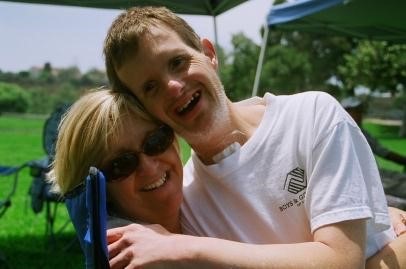
The sandwich generation, that’s us; baby boomers who find themselves sandwiched between careers and caring for our parents or other family members who can no longer care for them-selves. Caregiving is a full time job in and of itself; one which we take on with gusto and a full heart.
Taking on the role of caregiver usually means putting your own life aside for a season. Time once spent on the court, is now time spent sitting in doctor’s office waiting rooms, multiple trips to the pharmacy or ER, or learning to cook and shop for specialized meals.
Keep Your Sanity ~ Get Organized
Caregiving also takes an incredible amount of organization and attention to detail, especially if the one you are caring for requires multiple medications and has multiple medical specialists.
In my seven years of caring for my brother, who had up to nine simultaneous medications, some requiring daily dosage changes; four doctors – specialists in their respective fields – visited monthly; regular lab visits; two pieces of medical equipment to maintain; weight, liquid, and sodium intake charts to update daily; weekly reports and daily phone calls to one of his specialists; and a specialized diet to prepare – organization was as important as were his medications.
My saving grace was a 3-ring binder with color coded tabs. Each specialist was assigned a color, which correlated with the color of ink used to document each doctor’s appointment dates and times on my month-at-a-glance calendar – yes the good old hardcopy variety!
Since each doctor was associated with a different medical group, exchanging information from my brother’s appointments with each other didn’t always happen, and having the left hand know what the right hand was doing was essential. Given today’s technology, every doctor’s office receptionist has the ability to print out the doctor’s notes from that visit before you leave the office. Conveniently enough, they also all have 3-hole punches! My notebook was always with me and updated immediately with each doctor’s notes. Not only did this help me keep my brother’s medical issues organized in my overloaded brain, the doctors loved my notebook! I took it to every visit we had with every doctor. The cardiologist always knew what was happening with the pulmonologist and the oncologist, including the individual lab reports each one of them had ordered; which gave them the ability to adjust their recommendations accordingly.
My, not so little, notebook also helped me in other ways. I had a tab for meal plans that kept with-in my brother’s dietary restrictions, and recipes that were nutritious and palatable for everyone. I had a section for contacts that were easy to access in an emergency, people and organizations that offered help when needed, insurance documents, and notes of the nurses and doctors favorite things, said in passing, to reference for gift ideas at Christmas time.
Employing Your Tennis Racquet Bag off the Court
As you can imagine, this was a lot to haul around! Not wanting to carry a very large purse or high school style backpack, it was time for my, very fashionable, tennis racquet bag to come out of the closet. It was perfect, stylish, and held everything I needed while sitting in a waiting room for hours on end. Did I mention it was stylish?
I kept my bag packed and ready to go at a moment’s notice, which made trips to the ER less frantic. Aside from my notebook, I always had new bottles of water, my Kindle, an extra pair of reading glasses, money for parking, my favorite tea bags, some chocolate (always a blessing during long nights in the ER), a sweater and a pair of warm socks – as hospitals are often cold – and an extra house key – don’t ask.
There’s an App for That!
Since the days of caring for my brother I have discovered an app called CareZone Mobile – https://carezone.com/home . Since an android version of the app wasn’t available during the time I cared for my brother I have not used it personally (the app is now available for android and apple products). However it looks like it will store all the information the binder did and then some – and it’s free!
Whether you use the binder system or an app to keep yourself organized, I still recommend having a bag packed with ER trip essentials; just in case.
As caregivers, we may not be serving up victories on the tennis court, but we are serving up a lot of love!
About Suzi:
Suzi Martel is a freelance lifestyle writer who was a caregiver for her brother for over seven years. She has a heart for helping others and has made it her quest to write informative, entertaining copy on a variety of topics.
Your Complete Guide to Mastering Healthy Eating on a Budget:
by Chef Jessica Leibovich
Many families spend up to half of the money they earn monthly on meals making it one of the largest expenses. It doesn’t have to be, though, there are ways to keep the food costs down and still eat healthy delicious meals. Healthy eating isn’t rocket science, but our stressful and busy lives make convenience items and restaurants seem more appealing than a healthy and budgeted home prepared meal. If you make healthy eating convenient and affordable at the same time, you’ll have no problem switching to better food. It will just become a regular habit.
Healthy doesn’t always mean expensive, but it always means real. Real food is healthy. Eating whole is eating healthy. If it is in a box or a bag, just because it does not have a lot of calories, does not mean it is healthy. Make your own food! Eat fresh, eat whole.
If you are not used to cooking your own food, there will be a bit of an initial investment in stocking the kitchen but you will quickly see it pay off as you eat from home more and more often.
I also strongly suggest you get a good kitchen knife. This will make cooking more enjoyable. You do not need to buy an expensive set. Having just one chef’s knife and a good paring knife, is really all you need.
Here are two great knives that will literally last a lifetime (if you treat them well).
Chef’s Knife: http://amzn.to/1Z65wgf
Paring Knife: http://amzn.to/1Z65m8F
Chef Jessica’s Top Ten Tips to Healthy Eating on a Budget:
- Do your own grocery shopping and cooking for as many meals as you can: I recommend all breakfasts (breakfast out is almost never healthy), 5 lunches, and 5 dinners all be made from home. That gives you 4 meals a week to eat out. This is the most I would suggest. To me, this is a lot! Does this sound challenging to you? If so, you are probably spending too much on food and not eating as healthy as you could.
- Shop from the circular: Before you even head into the grocery store, you should read the circular or weekly ad and find out which items on sale you would like to buy. You can view it online or grab one in the store before you start to shop. I will often plan my meals from the circular. This alone will save you a ton of money!
- Go to more than one store to find the best price: Often different stores have different items on sale. Finding what stores or farmers market vendors have the best prices for your favorite item is the most cost efficient way to shop. Limiting this to two stores will minimize time constraints as running all over town will defeat the purpose. In my community of Carlsbad, I love Sprouts for meat and produce, Costco for a few staples, and Farmer’s markets for additional veggies
- Keep a rotation of favorites and plan your meals: Honey Chicken Mondays, Taco Tuesdays, Flank Steak Wednesdays, Dad’s Famous Chicken Sundays, etc. They don’t always have to be on the same day if something is not looking fresh at the store or another item is on sale but having a solid 5-7 meals that everyone loves on a weekly rotation will ensure you have many of the pantry items available which saves time and money. It also is less to think about when answering the big question “What’s for dinner?”.
- Shop seasonally: Asparagus is $1.97 a pound in the Spring but $4.99 in the Fall. Often shopping seasonally will naturally happen if you shop from the circular but by shopping in the season you are using nature’s bounty to your advantage.
- Be Mindful of your portions: When food goes into the trash that is just like throwing money away. Try shopping more often like two or three times a week, each trip just getting what you need for the next few days. If you have a stocked pantry, you will mostly be filling up on fresh items such as produce, meats, dairy, and nuts. Using smaller plates for meals, especially for dinner will not only help you keep your weight optimal, it will reduce waste of food. Take smaller portions and if you want seconds, go for it, but if not, use the leftovers as the lunch for the next day. This will save you money as well.
- Avoid Impulse Buying. The best way to avoid impulse buying is to prepare yourself before you do the grocery shopping. Make a list and stick to it and eat before you go shopping. Try not to shop when you are hungry! If you are in a big chain supermarket, sticking to the ends of the market and staying away from the middle will help with this objective.
- Keep an organized fridge and pantry. Leftovers and make ahead meals to freeze are always great, but it totally defeats the purpose if they get lost in the back of the fridge. Label leftovers and keep your fridge organized to help minimize food waste. Go through the fridge weekly and the freezer twice a month to utilize items before they go bad.
- Stock your kitchen with a variety of different items to make it easier to pull together meals on the fly. Keeping your kitchen stocked with staples and a variety of items you use every day.
Here is a sample list of some great things to keep on hand. Keep in mind, this is just a short list of suggestions and you can change this and customize it to your family’s preferences.
Staples: pasta, lentils, rice, sweet potatoes, polenta, quinoa, bread, peas, potatoes
Vegetables: tomatoes, cucumbers, green beans, broccoli, corn, fresh spinach, celery, and carrots
Dairy and eggs: cheese in bulk, Greek yogurt, eggs, organic cream and butter
Fruit: apples, bananas, oranges, seasonal fruits such as berries
Pantry: peanut butter, almond butter, tuna, beans, coconut milk, broth, canned tomatoes, tamari, honey and nuts
Meat: Chicken whole or butchered, ground turkey, grass fed ground beef, flank steak, lamb stew
Spices: salt, pepper, paprika, cumin, chili powder, lemon pepper, cinnamon
Cooking: olive oil, garlic, onions, Dijon mustard, Balsamic vinegar, rice wine vinegar, apple cider vinegar, coconut sugar
(All of the food mentioned here also happens to be great for fitness and muscle building, boosting your immune system and aiding in post workout recovery.)
And my final rule for mastering healthy eating on a budget….
10. Grow Your Own Food. It’s cheaper than frozen and it tastes better and you control what chemicals are sprayed. Plant your own trees that grow berries, walnuts & apples. Buy chickens for free eggs & meat. Google Square Foot and Container Gardening for more ideas.
Thanks so much for reading! What is your favorite money saving tip?
Tapas Acupressure Technique®: Did I just heal that?! Really??
Chris Lewis, P.A.-C.
It is pleasant to think that once the experience of a trauma finally ends for us, our reaction to it also ends. However, past traumas can and do intrude on our current life. For most of us, these intrusions—sometimes referred to as “re-experiencing” a trauma—are inevitable, usually unpleasant and definitely persistent.
Although recurring cycles of re-experiencing may be powerful and painful, they are also the very moments in which we may profoundly shift our lives. In those moments, we may permanently heal cycles of re-experiencing for the last time.
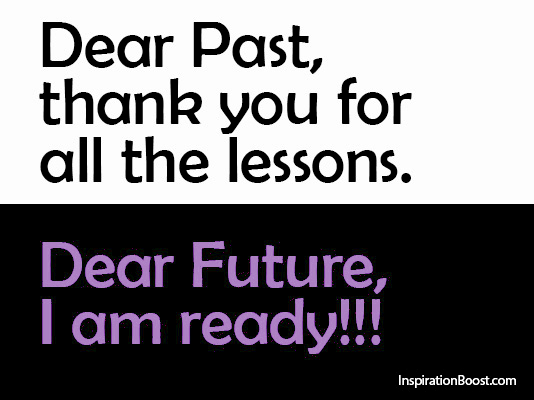
The relief and surprise associated with suddenly healing the pain of traumas, unwanted behaviors and emotions as well as dispelling related symptoms of physical stress are common with the use of Tapas Acupressure Technique® (TAT®). Although the notion seems illogical or even impossible, experiencing a prompt, sustained healing of issues is exactly what we see for many of our patients.
What happens?
How do these transformations occur?
Why are they necessary?
Perhaps to reach the best perspective, it may be useful to begin at the beginning. Although it could happen at any age, let’s say there is a traumatic incident most likely at a young age—something that happens to us or to someone we love and care for, or even to someone we don’t know. Let’s also assume that in the moment of the incident, you become quite clear that you do not want to experience the physical, emotional and mental stress related to this event again—not ever. What can we do?
We may not be aware of it, but we create a response. We do it easily as if it were in our nature to do so. Well, it is in our nature, it is primitive, and we believe in the moment that it contributes to our survival. We are instinctively self-protective and will do our absolute best to create safety or at least the illusion of safety in the moment. Further, in the absence of any truly effective solution, the illusion of safety is one we will allow ourselves to accept. We will go so far as to defend it even if we suspect in some small way that in the end it may not really work to save us.
Are we aware of all this? Do we do any of this consciously? For instance, do we as young children readily respond to trauma logically and with sophisticated coping strategies? That sort of response points to higher levels of consciousness and situational awareness not normally demonstrated in children of younger age. If we are honest with ourselves, we as adults presumably with greater understanding of life’s situations, continue to respond to difficult circumstances in a fairly emotional way and not much beyond that. However, leaving aside the possible lack of specifics and logic in our response to trauma, what we do create is a personal, implicit or non-conscious knowing related to these events. It is a sensible, meaningful, well-defined construct or schema, which is emotional, perceptual, physical and nonverbal yet rarely shows up in our conscious experience; that is we don’t necessarily know we’re doing it. Nonetheless, we have our newly created protective response (or construct) tight in hand and we are prepared.
If a future event comes along that looks anything like the original traumatic event, we have a plan (our implicit personal construct or scheme); a mostly unconscious plan and, again, it is the best plan we could create in the moment of the event. Without realizing it, our plan or construct literally becomes a new reality for us: “Because of what happened, this is my reality now.” etc. We want to believe that if we live life through our new reality it will spare us the particular brand of discomfort we first experienced. In sounds reasonable, but there’s a catch. If we peer behind the curtain of our new protective response we may discover it is not much more than a symptom generator and in this case, it’s not the good kind.
As we’re going through life, things happen that may be similar to the original trauma event and suddenly, we are responding. We are reactivated and our protective construct is in full charge. Painful emotions, body sensations and thoughts are all happening just as before. Consciously or not, we experience the original event in all its glory and are seemingly unable to control what we feel. We begin to take action, say things or perhaps move physically in a way that is consistent with our protective response—run, cower, fight, etc. If anger is involved, we may find ourselves yelling at someone or perhaps simply fuming inside trying to control ourselves. What may appear to others as irrational, out-of-control symptoms are to us sensible, sound, orderly expressions of our existing response or construct—our perceived reality. Do we not believe our actions justified or compellingly necessary while we are in the throes of such an experience? Are we not, once again, doing the best we can for ourselves?
No matter how much we may wish it otherwise, our perceived realities tend to run our lives. A corollary belief is that we can do nothing about relieving the pain they generate with each recollection. They seem permanent. Besides, if we did not take care of ourselves in these situations, what else would we do? Do we return to being unprotected? Not likely. How do we deal with this?
Until you make the unconscious conscious it will direct your life and you will call it fate.
~ C.G. Jung.
Neuroscientists believe that our emotional learnings (e.g., trauma) drive the vast majority of unwanted behaviors, emotions, thoughts and physical symptoms. As many of us concluded through personal experience, they too believed these emotional learnings were permanent. However, in the late 1990’s researchers discovered that the brain provides a key for unlocking this permanence. Knowing the how to use that key makes it is possible for us to discontinue unwanted symptoms and behaviors permanently. That is to say, they are erased—not just changed, but erased, eliminated. The study of TAT and other evidence based energy psychology modalities (e.g. Thought Field Therapy, Emotional Freedom Technique) show that it is possible to activate the ability of the brain to unlock and erase unwanted emotional learnings.
So, in brief, the cycle is this: A negative or trauma event happens; an emotional learning occurs. In response, a protective construct is created that later becomes a generator of symptoms when a perceived set of environmental conditions are present—that is, when we suffer a re-experiencing. By design, this whole apparatus is locked or consolidated in certain parts of our brain and waits. As soon as our construct perceives certain reactivating environmental conditions, it generates a set of symptoms felt to be compellingly necessary. We cease producing these symptoms as soon as there no longer exists any construct of reality in which our symptoms are necessary to have.
In the hands of an experienced practitioner, this cycle may be broken with TAT. During a typical session, the goal might be to resolve a known trauma (perhaps the shock of receiving a diagnosis of cancer), the patient briefly focuses on the manifestation of the trauma, its origins, and the locations in which it has been stored in both the body and mind. Through the TAT process, the tension surrounding the event relaxes and allows energy to move freely through related physical, mental and emotional spaces once again. There is suddenly room around the issue, so to speak, and the part of you that has been dealing with all of this relaxes too. There is sense of relief as the issue moves toward resolution.
In neuroscience research, an issue is resolved or erased with TAT when it has adheres to three well defined criteria. The three criteria must be met for an emotional learning to be verified as erased or resolved:
1. Emotional non-reactivation.
If a set of conditions shows up in our life that would normally trigger our protective construct, we no longer react to it and there is no need to work at keeping ourselves from reacting. Instead, we just don’t react because there simply is no need to react nor is there resistance to reacting. It becomes more passive, an observation, a simple noticing that we didn’t react this time and we did nothing to make sure that happened.
2. Symptom cessation.
The symptom, originally part of the protective construct (symptom generator), simply no longer occurs in the presence of required environmental conditions.
3. Effortless permanence.
Our issue remains resolved with no effort on our part. In fact, the issue becomes historical, a simple uncharged memory of the issue. We remember it, but it there is no compelling need to deal with it.
CONCLUSION:
One question we ask at the beginning remains open: Why is it necessary to do anything about the unwanted issues, the emotional learnings we find in our lives? The simple answer is we do it because they disturb our peace. On a deeper level, they disturb our ability to love.
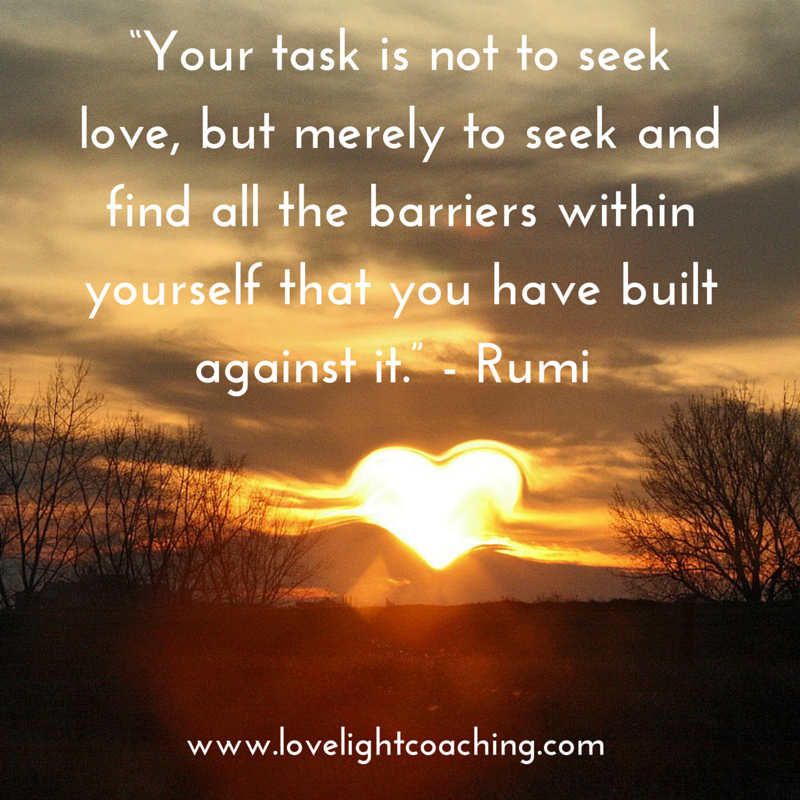
One of my professors once told us, “We are Divine beings having a human experience.” Looking back on my own life at that moment and reflecting on a few events within it, I wasn’t so sure about the divine part, but I was clearly having a human experience. The scenario above is something we may use as an example of what can disturb our peace and our ability to love, but many things in our daily lives can upset us. Until recently, unwanted responses to those events were believed by science and us to be permanent. I am grateful for this technology and for the opportunity to heal my own barriers.
With Love and Respect,
Chris E. Lewis, PA-C
Senior Physician Assistant
Integrative Oncology
UCSD Cancer Center
Encinitas, CA
For more information about TAT: TATLife.com
To contact Chris Lewis, PA-C for an appointment or for more information about his private practice: info@sdcri.org
Cancer Treatment, Cancer Survivors, and Lymphedema: the Truth About Your Risks
Dana Wylie, Certified Lymphatic Therapist
These days, when clients come to see me, many are coming in specifically to either reduce the effects of lymphedema or to mitigate their risk of developing lymphedema. Once I leave the office, however, the level of overall awareness in the community of cancer survivors drops dramatically. Outside of my office, roughly 1 in 4 cancer survivors that I talk to who are at risk of developing lymphedema are completely unaware that the condition exists, and that risk will last a lifetime. If I factored in the amount of misinformation that I hear, the numbers grow.
What is Lymphedema?
Lymphedema is a high protein accumulation of fluids in the interstitium (skin) causing swelling (edema). The swelling generally manifests in the limbs, but can occur anywhere in the body including the trunk, breasts, head and neck, or even genitals.
The lymphatic system is responsible for the removal of interstitial fluid from tissues. It also transports infection-fighting white blood cells to and from the lymph nodes. Lymphatic fluid is generally transported out of an area through the network of vessels and ‘cleaned’ by lymph nodes along the way. During surgery and/or radiation, the system becomes damaged. Lymphatic vessels are cut.
Often times, those vessels can re-route themselves but may also become obstructed by scar tissue. Lymph nodes are surgically removed. Radiation can alter the nature of tissue in its field rendering some vessels and/or lymph nodes unable to function properly. Unlike the lymphatic vessels, however, lymph nodes that are removed or irradiated are unable to regenerate.
It is the damage to the lymphatic system that can render an area of the body incapable of fully dealing with infection, trauma, and fluid accumulation in the tissues. Once the high-protein fluid begins accumulating, it attracts more fluid, and the result is lymphedema.
What is My Risk?
Among the possible causes of lymphedema, the number one cause in Western world is cancer treatment. Of those cases of lymphedema, 79% will result from breast cancer treatment, 3% will be from head and neck cancers, and the remaining 18% from treatment of other cancers.
There’s a lot of misinformation circulating out there, and while the numbers may vary between studies and certified lymphatic therapists, the basics remain the same.
You are at risk for developing lymphedema if:
– You have had at least one lymph node removed
– You have had radiation treatment, whether it was internal or external
In the oversimplified version of risk assessment, we may use a standard 4% per lymph node surgically removed as a guideline which is increased significantly with radiation. The truth is more of a matrix.
Risk increases:
– By increasing numbers of lymph nodes removed
– Additionally by radiation treatment
Risk decreases:
– By the amount of time that has elapsed since the time of surgical or radiation intervention.
There is no such thing as ‘zero risk’ with only one or a few lymph nodes removed. I have had clients with one lymph node removed come out of surgery with lymphedema. The risk is simply lower over all.
There also isn’t a magic number of years when the risk is not present. I have met people who developed lymphedema 25 or more years after their cancer treatment. The risk simply decreases gradually over time.
The Good News: Knowledge is Power!
It’s so very important to understand if you are at risk of developing lymphedema so that you can consciously take precautions and do activities that improve the health of your immune system.
– Exercise/Deep breathing: Movement and breath are the ‘pumps’ of our lymphatic system. Regular exercise is key.
– Learn to properly perform Self Manual Lymphatic Drainage: manually guide lymphatic fluid from compromised regions to healthy regions of your lymphatic system
– Get monthly professional manual lymphatic drainage: while it may seem like a luxury, it’s a medical necessity to work with a professional on a regular basis. The quality of what a professional Certified Lymphatic Therapist or Certified Manual Lymphatic Drainage Therapist will do is generally different and much more thorough that what you can perform at home.
– Get compression garments and wear them during activities that can trigger or aggravate lymphedema such as air travel, long car rides where changes in elevation occur, and exercise.
– Avoid extreme hot and cold to the affected area: sun bathing, hot tubs, saunas, heating pads, etc. and frost bite.
– Avoid needle sticks, scratches, cuts, punctures to the affected area(s): these can include blood draws, pet scratches, and gardening injuries (wear gloves!), etc. that cause inflammation or give opportunity for bacteria to enter
– Avoid constriction on the affected areas: blood pressure cuffs, rubber bands, jewelry/watches/clothing that is too tight
– If possible, avoid trauma to the affected area
– Don’t overwork muscles in the affected area: avoid lifting heavy objects to the point of getting sore muscles
– Practice healthy skin care: use hypo-allergenic lotions to keep skin supple and moistened and to avoid cracking or other break down of tissue.
– Report any changes you experience to your health care provider: swelling, heaviness, achiness, and skin sensitivity should be evaluated by a professional
While it sounds like a lot to overcome, it can easily become second nature to take care of your lymphatic system to reduce your risks, and there are professionals and organizations that are around to help. One of my favorite resources is the National Lymphedema Network (www.lymphnet.org) for guidelines, research, and resources of professionals in your community.
Qigong for Cancer Treatment and Recovery
by Fay McGrew, M.A., Certified Qigong Teacher, Q.T.P. (Medical Qigong)
What is QiGong?
Qigong or Chi Kung [pronounced Chee–kong]’ “Qi” means life force or bio-field energy, “gong” means cultivation, practice, effort.
It is based on the ancient Yang Sheng [Nourishing Life] longevity practice that includes meditation, energizing breathing techniques, gentle invigorating movements, nutrition, and sleep patterns all in harmony with the rhythms of nature. When these aspects are integrated it strengthens the core and enhances natural healing abilities for the body, mind and spirit.
Today Qigong is regarded as a branch of Traditional Chinese Medicine, the self-care practice to support acupuncture and other healing modalities.
If you search “Qigong and Cancer” on the internet, the results are overwhelming with numeorus articles and evidence based studies on its benefits.
So, why is Qigong so effective?
It is because the jewel of the practice is how to use your mind to heal through cultivation of life force energy. This is why Dr. Vicario sites Qigong as a vehicle for epigenetics, how to change your DNA and body chemistry to heal from or prevent potential health challenges.
Qi is also strengthened by release of stagnated energy through gentle flowing easy to follow exercises and self massage of key acupuncture points, it’s like acupuncture without needles.
There are many different styles and approaches to Qigong. I learned classical Qigong, movement oriented practice, but fell in love with a modern therapeutic system called Zhineng “Intelligence-Wisdom” Qigong. It was developed in a clinical setting by Dr. Pang Ming, trained in Chinese and Western medicine as well as a Qigong master, proving very successful to the thousands of patients who resided at his Healing Center. I also teach several systems of Women’s Qigong supporting gynecological and breast health. These exercises are not only excellent for recovery but prevention and maintaining optimal women’s health .. see article I wrote Light Connection.
I was honored to teach Qigong at the San Diego Cancer Research Institute for 10 years when we offered those services. As much as the patients enjoyed the movements, they truly appreciated the guided imagery and healing intention portion of the class, and applied these techniques while waiting for an MRI, during chemotherapy treatments, or at home resting.
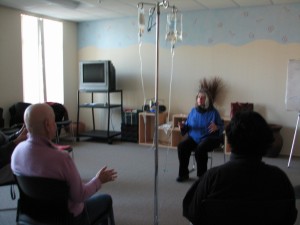 Fay teaching Qigong at the San Diego Cancer Research Institute while patients were receiving IV treatment.
Fay teaching Qigong at the San Diego Cancer Research Institute while patients were receiving IV treatment.
Today I mostly teach active duty servicemen and women recovering from their mental and physical injuries. We ask them to report levels of pain, discomfort, anxiety and depression before and after each Qigong class. Most levels drop with “anxiety” significantly decreasing. There is so much stress in all aspect of one’s life when undergoing treatment for serious conditions, and this stress as Dr. Vicario points out is as damaging as the health challenge itself. Learning how to relax your body and mind builds resiliency which is life saving!
Why haven’t you heard about Qigong before? In the West, Qigong is conflated with Taiji Quan or T’ai Chi Chuan. Even the Western medical research community confuses these modalities as Qigong exercises are used as warm up and cool down during Taiji classes. Both arts share the same premise of how to move the body as a way to enhance energy and remove blockages. However, the specific techniques are different because Tai Chi is a martial art, and Qigong is exclusively for health.
But now you know about Qigong! Want to try it? Its really simple and can be for whatever amount of time you have. The key to get the most benefit from it is to do it everyday.
Qigong Healing Breathing Practice
Sit in a chair with back straight, support your lower back with pillow if needed.
Relax your entire body, especially your shoulders.
You may close your eyes; or keep them open with a soft focus gazing down at a 45 degree angle.
Bring awareness to your breath. Focus on your diaphragm (attached to the bottom of your lungs) moving down as you inhale and up as you exhale. Experience how this deep relaxed breathing is massaging and detoxifying your organs.
Notice how your body is responding, being nurtured by needed oxygen.
Observe how your brain, needing the most oxygen is responding to this deep relaxing breathing.
Feel each inhalation nourishing and healing every cell in your body.
Experience each exhalation releasing all that does not serve your body, mind and spirit.
Continue for as long as you have time for, suggested 15 minutes.
Open your eyes.
Grounding Exercises (modify to your physical ability)
Raise your leg and slowly move it from the knee up and down, then isolate turning ankles 3x in each direction; repeat the same on the other foot.
Slowly bend down from your waist as far as you can, relax your head forward resting on your chest or as close as possible.
Pause and notice how your spine is gently stretching as you relax more.
Slowly raise up opening each vertebrae keeping your chin as close to your chest as possible, the last to come up is your head.
Smile.
Say or think “All is well, all is well, I am well”.
Where can I find out more about Qigong and find a local teacher?
There are 3 organizations where you can find more information about Qigong and locate certified teachers:
National Qigong Association www.nqa.org
Qigong Institute www.qigonginstitute.org
American Tai Chi Qigong Association www.americantaichi.org
Enjoy your Qigong journey of empowerment, optimum health, healing, and inner peace.
All is well, all is well, you are well.
Sending you loving healing Qi,
Fay
SDCRI’s 2015, Year in Review
by Daniel Vicario, M.D.
The San Diego Cancer Research Institute, a nonprofit organization created in the year 2000 by Drs. Mark Adler and Daniel Vicario, is composed of two divisions: Genomic Oncology directed by Dr. Mark J. Adler, and Integrative Oncology, directed by Dr. Vicario. The Integrative program started offering free complementary services in 1995 thanks to the generosity of several successful practitioners of the different healing arts who offered their time and skills as volunteers servicing the community of cancer patients. This program started at the San Diego Cancer Center in Vista and Encinitas with the intention of offering cancer patients the option of experiencing complementary healing modalities that were proven to improve patients’ quality of life. It was open to all cancer patients in the San Diego community. This program was extremely successful, offering services to over 150 cancer patients every month with an average of 100 visits per week. At one point there were over 50 active volunteers. During its last ten years, the program’s coordinator was Mary Hollander, RN. Without Mary’s support and guidance we could not have reached everything the program was able to accomplish. Unfortunately, for the several reasons mentioned in previous news articles on this web site, the SDCRI’s free integrative services facility in Encinitas had to close in December 2014.
The good news is that the San Diego Cancer Research Institute remains active in its mission of education, collaboration and research. Since the closing of the free integrative services facility in Encinitas, SDCRI has continued its education and research collaborative efforts with several other institutions and has remained an active web-based resource. The Integrative program team will continue to update the webpage with news, Integrative and Genomic Research updates, Nutrition and Oncology updates, Dr. Paul Brenner’s videos, the latest info on the Hope Made Visible Project, educational programs, videos and more. Mary Hollander and Juli Shelton continue to help with SDCRI’s Integrative program and update the website on a regular basis. SDCRI will continue to expand in 2016 with its online nutrition program: Reality Based Nutrition with Mary Hollander RN, Dr. Paul Brenner’s Blog, SDCRI’s integrative oncology projects, collaborative research, educational videos, etc.
Dr. Dan Vicario, SDCRI’s Medical Director and Director of Integrative Oncology, is collaborating in various broad based Integrative Research projects. He is working with several scientists, health practitioners, educators, researchers, professionals, nonprofit Institutes and academic institutions to continue to expand research in the importance of embracing proven integrative healing modalities to support cancer patients. Research projects include the fields of nutrition, exercise, yoga, mind body practices, massage, psychoneuroimmunology, acupuncture, biofield therapies, art therapy, aromatherapy, and others.
Dr. Vicario is also collaborating with practitioners, professionals and researchers in naturopathic medicine, homeopathic medicine, and ancient healing traditions like Ayurveda, Chinese medicine, and Indigenous medicine.
Current SDCRI’s collaborations include:
-U.C. San Diego Cancer Services
-UCSD Center for Integrative Medicine (CIM): http://cim.ucsd.edu/
-UCSD Center of Excellence for Research and Training in Integrative Health (CERTIH)http://fmph.ucsd.edu/integrative-health/coe/index.html
-Chopra Center and Chopra Foundation: https://www.choprafoundation.org/
-Consciousness and Healing Initiative (CHI): http://www.chi.is/
-Guarneri Integrative Health
-Miraglo Foundation: http://www.miraglofoundation.org/
-Scripps Center for Integrative Medicine
-University of California, San Francisco (UCSF)
-Institute Of Noetic Sciences (IONS): http://www.noetic.org/
-Resolution Care: Dr. Michael Fratkin and Team: http://www.resolutioncare.com
At a recent SDCRI board meeting, Dr. Vicario also gave the following updates:
- Research protocol collaboration between SDCRI, UCSD, Chopra Foundation, UCSF: “I-CAN”: Initiative for Cancer Survivorship Approached Naturally. For this research project, patients who are breast cancer survivors will attend the “Perfect Health” healing program at the Chopra Center in La Costa resort. Several markers of healing and quality of life will be measured before and after the 6 day retreat. The UCSD IRB has already approved this research protocol.
- The San Diego Cancer Research Institute, Dr. Dan Vicario and SDCRI’s Integrative Program have partnered with the “Consciousness and Healing Initiative (CHI)” to support its purpose, projects, research and service. CHI is an international collaborative accelerator of scientists, health practitioners, innovators, educators, researchers, professionals, artists, individuals and nonprofit institutions who share CHI’s vision. For details on the “Consciousness and Healing Initiative (CHI)” please go to this link: http://www.chi.is
At this time, SDCRI offers CHI “in kind” administrative support and is also its fiscal sponsor until CHI becomes its own separate nonprofit entity. - SDCRI continues collaborating with UCSD Center of Excellence for Research and Training in Integrative Health (CERTIH) and Center for Integrative Medicine.
- Paul Brenner, M.D. continues with his educational videos and working on research in Epigenetics.
- Alessandra Colfi, Ph.D., continues to expand the International Hope Made Visible™ (HMV) project: creating and sharing artful flags among cancer patients, survivors, families/friends, and caregivers. This project has created over 1,000 flags, from all over the USA, Canada, Colombia, Argentina, Guatemala, Ghana, France, Germany, The Netherlands, Italy, and Australia. These flags have been sent for exposition to Europe and throughout our community for display in several venues. Hope Made Visible™ has also collaborated with Habitat for Humanity’s Veterans
- Vicario was invited to be a speaker, with two other UCSD Faculty Professors, at the University of Chile’s International Conference in Integrative Medicine, which took place in Santiago, Chile, from August 17 to 19th, 2015.
- The SDCRI Integrative Volunteers met again at the annual “SDCRI Integrative Medicine Volunteer Appreciation Dinner” which took place on October 9th, 2015. They were again thanked and reminded of how grateful SDCRI and the community are for their outstanding care and service. It was a very productive meeting and the volunteers continue to express their gratitude for the experience they had working with cancer patients over the last decade.
- Vicario continues to be a Faculty speaker at the Chopra center educational program “Journey into Healing”, which takes place twice a year.
- SDCRI has organized collaborative meetings between Dr. Ralph Greenspan, co-creator of the “Brain Initiative”, Dr. Paul Mills from UCSD CERTIH and Dr. Paul Brenner.
- SDCRI has obtained two trademarks: “San Diego Cancer Research Institute” and “Hope Made Visible”. SDCRI is working on obtaining the third trademark: “The Promise of Research, The Science of Healing”.
- SDCRI website has added the PowerPoint slides from Dr. Vicario’s Integrative Oncology Presentation at UCSD Center of Excellence for Research and Training in Integrative Health (CERTIH) on November 10, 2015.
The Integrative program volunteers and the San Diego community continued to be an integral part of SDCRI’s continued growth in 2015. Dr. Vicario and the SDCRI board remain deeply grateful for all this support.
The Benefits of Gentle Yoga for Cancer Patients
By Justine Shelton
My name is Justine Shelton and it has been my honor to teach gentle Yoga to cancer patients since 2006…and boy, have I learned a lot along the way! I am a Certified Yoga Therapist and my education did help prepare me to work with this population, but I have to say that most of my learning has been from the students themselves. There are now many studies supporting the benefits of Yoga and stress reduction for cancer patients. What I want to convey here is the benefits shared with me by my students – for that is who truly matters!
I believe the greatest gift of Yoga for cancer patients is the benefit of stress reduction and calming the nervous system. Stress is a huge factor in 90% of disease. Teaching patients ways to relieve stress is a huge skill to help them in their RECOVERY.
One of the things I first tell people when I am asked about the benefits of Yoga for cancer patients is the benefit of self empowerment. My perception is that when a cancer diagnosis is given, the world of that patient flips upside down. There are now treatment plans, scans, surgeries, chemo….the list goes on. Many people report feeling a sense of loss of control. For me, Yoga helps give them tools to take their healing and state of mind into their own hands. To not just turn their health over to someone, but to become part of the team and an active advocate for themselves. Even if for only a couple hours a week they have a chance to just be with themselves and to be with others who can truly relate to what they are going through – that is huge! As the ‘teacher’ I could say I understand what they are going through….that is not true – I have empathy, sure – but I have not walked in their shoes. The other students there have and they SO appreciate each other. That is when I learn the most, listening to them share with each other.
The other important factor in healing from cancer is the benefit of community. We have the time we are together in class – a bit of a respite from the outside world (and isn’t that a huge gift?!), a time to focus on their body and breath, a chance to speak with other patients and share information and tidbits about doctors, treatments, etc. However, I try to make sure they go away each week with what I call ‘Yoga Snacks’ – small things they can do to take care of themselves at home by resting and calming their nervous system; breathing practices they can do in the doctor’s office or scan machine to abate anxiety; tools to help them fall asleep; guided meditations to aid the healing process.
Gentle Yoga gets the body moving in a safe and supported way. There is a constant reminder to breathe – slowly, gently and deeply – helping to oxygenate the tissues in the body and assist in detoxification. Careful attention is given to moving all the joints of the body – my feeling is that joints are like roundabouts, where the ‘traffic’ of the body could get congested – movement aids in circulation throughout the body, keeping the body from getting stagnant.
My classes have people participating from all stages of treatment, some coming to Yoga for the first time. This is a place of no judgment – come how you are, go at your own pace, enjoy spending time focusing on your body, mind and Spirit. Rest is encouraged, not ‘pushing’ through something painful. A reminder to listen to their own body, to go at their own pace…..and to have FUN! (OK, I’ll admit it, some students think I should do stand up! But, in my opinion, laughter heals!)
I believe Yoga can help one make peace with their body. Some cancer patients are angry at their body for what it is doing. When I was asked to start running the cancer Recovery program at Yoga Vista Studio in 2009, I thought long and hard about how I bring my classes out of the final relaxation pose. I always finished with a moment of silence, palms pressed together at their heart center, and would say – ‘Bow to yourself. Honor the effort of your practice. Honor this beautiful body that serves you so well. And honor the light inside each one of us.’ What gave me pause was the line ‘Honor this body that serves you so well.’ I decided to keep saying it. And sure enough, a couple years in a student commented on it (after she got to know me quite well!) She said the first time she heard me say it she thought ‘Who is this b*#*h?! And what is she talking about?’ But she shared with me that it caused her to think about it and what she came up with was her body was not the enemy, it was actually fighting quite hard for her, there were just some rogue cells getting out of hand. She thanked me for sparking a new perspective. (And we had a good laugh!)
I encourage my students to practice a 20 minute savasana (focused, supine relaxation) EVERY day if they can! I remind them that they are worth the time it takes to slow down, relax and focus on themselves and their well being. In this role, Yoga teachers are their advocate. We all have trouble treating ourselves to self care. I remind them it is NOT selfish to take time out for themselves, their bodies, their Spirits and their emotional well being. My goal is to help them love themselves more than they ever thought they could!
The Feldenkrais Method®: Improving Function Through Awareness
By Anita Noone
One of my long-standing clients, let’s call her Ann, was diagnosed with breast cancer She explained her situation to me after class one day and told me she might not make it to class because of her treatment schedule. She disappeared for a while and I thought of her often, wondering how she was doing. Finally, after a few months, she showed up at class with a big smile on her face. She was clearly happy to be back.
The class Ann attended was held at a community center on Monday evenings. People arrived in ones and twos, some of them straight from work. We laid mats on the floor and set up a low, padded table for a participant who couldn’t easily lay on the floor. At the appointed hour, I began: “Stand, and sense how that is – what muscles are working hard as you stand? Sense your feet and where the weight is in them; are your knees bent or straight? What are you doing with your shoulders? Where are your eyes looking?” I glanced around the room, pacing my questions so everyone had time to notice. Some people had closed their eyes. There was a shift in the room, from being outwardly oriented – thinking about the room and other people – to an inward orientation of each person attending to his or herself.
I continued to direct attention to internal sensations, as people laid down on their mats and made themselves comfortable. For 50 minutes, I suggested small, slow, gentle movements. The movements began very simply and became more complex. People experimented with different ways to do the movements easily. All through the lesson, I directed attention – to the eyes, to the breath, to places that weren’t moving – or were they? Most eyes were closed now, as people alternately focused on everything that was happening inside and then completely let go and rested.
As the lesson came to a close, the students again came to their feet and walked around, sensing the differences in themselves from the lesson. Ann was still smiling, but her face was softer now, and there was a look of wonder in her expression. We made eye-contact, and she volunteered, “What a relief! I feel like all my parts are connected again!”
I teach the Feldenkrais Method of Movement Education®, and what Ann experienced that evening was a common, practical result of the work we do. All people move in accordance with the image they have of themselves in their brains, an image that they are largely unconscious of. Some areas of the body are very well represented in your brain – your lips, tongue, and genitals, for instance. And for everyone, there are areas that are less clear, like the back of the lower leg. You could think of this self-image as a mind map, a map that can always be improved and refined.
When you are ill or injured, the image you have of yourself changes and affects the way you move. You may move less or differently because of pain, fear, or anxiety. Unfortunately, these patterns of limited, protective movement may persist, even when you could comfortably move much more.
When Ann came to class, she brought a self-image formed by a cancer diagnosis and treatment. There had been various insults to her body and psyche, as well as a sense of having been objectified as a “patient,” a lab result, a pathology. During the Feldenkrais Awareness Through Movement® lesson, lying on a padded mat, in a dimly lit room, Ann was provided with the opportunity to discover how she felt and what she could do well and comfortably. The Awareness Through Movement lessons (there are over 1000 of them) are designed to be experienced without any time pressure, goals, or expectations. Ann’s willingness to observe herself and to rest during the lesson increased her awareness of how she was and what movements were easy to do.
Dr. Moshe Feldenkrais, creator of the Feldenkrais Method said, “The body reflects the attitudes of the mind. Improve the function of the body and you must improve the state of the mind. The movements are nothing….What I’m after isn’t flexible bodies, but flexible brains. What I’m after is to restore each person to his human dignity.”
Dr. Feldenkrais was a physicist, judo expert, mechanical engineer, and educator, born at the beginning of the last century. The Feldenkrais Method uses gentle movement and directed attention to improve human functioning. Feldenkrais understood that the improvement of physical functioning is not necessarily an end in itself. Improvement is based on a broader functional awareness, which is often the gateway to a more generalized enhancement of physical functioning.
The feeling of connectedness and ease that Ann experienced at the end of the Feldenkrais lesson is just one example of the many improvements that this learning and awareness practice can provide. Anyone can do this work, which makes it especially valuable for those who cannot currently exercise.
How Does Acupuncture Benefit People with Cancer?
By John Chang, Licensed Acupuncturist
When I ask my patients about the benefits they receive from acupuncture treatments, their answers can be very surprising. Typically, patients will mention the many known benefits that have been supported by scientific research and have been recognized by institutions such as the National Institutes for Health and the World Health Organization. People being treated for cancer often express relief from treatment-related side effects such as pain, nausea and vomiting, fatigue, hot flashes, insomnia, and anxiety, just to name a few. In this age of the internet, we often begin our investigations by searching credible sources online, such as those I’ve listed below, and discover the many validated benefits of acupuncture for people with cancer.
When I ask my patients about the benefits of acupuncture, I also get responses that are, to my delight, much less expected. These particular responses will point to something beyond what medicine typically provides. These responses often begin with an inquisitive stare as the person digs deep inside and reflects on what really keeps them coming back to acupuncture. They know that their bodies feel better, but there’s something more. They know they feel less stress, and their minds are relaxed. Something inside of them feels a deeper sense of peace. They also get a sense that it’s not just the treatment, but there’s an appreciation of the experience of coming into the clinic, being greeted by caring people, and enjoying a time of healing.
What I’ve heard many times from my patients is that acupuncture is healing on so many levels, and often a person can’t really describe what that means. “It’s just healing,” they say, and perhaps for the first time, they’ve come to understand what healing really feels like. When I listen to that person answer in that manner, I know that I’ve given them the best care that I can. It means that I’ve reached the many different levels of that person, which are often overlooked by our medical system. I’ve helped that whole person, and as a holistic healer, I know that I’ve done my job.
Acupuncturists are trained as holistic physicians. When we interact with a patient, we not only query into the state of that person’s body, but we will also ask them, “How are you doing?” on the many levels that make up who they are. We recognize that a person’s body, mind, and spirit are beautifully interwoven into a unique whole. We also seek healing for that person in the context of their environment and psychosocial landscape.
A good holistic practitioner will partner with you and respect your individual needs. This creates a relationship that is at the center of the healing experience. An acupuncture treatment epitomizes this relationship, because acupuncture is not simply the insertion of needles into the body. It is true that the insertion of needles has a profound effect on the nervous system and works systemically to heal the body on a deep physiological level. For the holistic acupuncturist, these benefits are only just the beginning.
For an acupuncturist, each insertion of a needle is more than just a medical intervention. There is a blessing imparted through that needle that captures the relationship between the acupuncturist and the patient, even if they’ve never met before. This relationship will be based on things like grace, acceptance, and love. This allows healing to take place in that instance. When a patient begins to understand this, they receive true healing, and this becomes the greatest benefit that acupuncture has to offer.
This benefit can also be expanded throughout a patient’s entire cancer treatment. This happens when all of the members of a medical team work together. A holistic acupuncturist who is experienced in serving cancer patients will work in close cooperation with all of these healers, including oncologists, nurses, dietitians, social workers, and patient navigators. This will ensure safety and create the maximum healing effect for that person.
All of the top cancer centers in the United States, including the MD Anderson Cancer Center and the Memorial Sloan Kettering Cancer Center, encourage integrative, holistic, and team-based approaches to cancer care. Your acupuncturist may have received training from these centers or may work directly with your hospital. It is important for people with cancer to seek health care professionals who have had extensive experience and training in oncology care, and who work in a team environment in order to optimize your healing experience.
When I ask people going through cancer treatment what benefits they receive from their care, I know that each person has walked their own unique, individual journey. Yet, universally we all seek healing on a deep level that reaches every aspect of our lives. Acupuncture is one of many healing modalities that is based on holistic principles, and it provides that care exceptionally well.
Resources
Mayo Foundation for Medical Education and Research [Internet]. Acupuncture; [updated 2015 Feb 21; cited 2015 Aug 1]. Retrieved from: http://www.mayoclinic.org/tests-procedures/acupuncture/basics/definition/prc-20020778
MD Anderson Cancer Center [Internet], Acupuncture; [cited 2015 Aug 1]. Retrieved from: http://www.mdanderson.org/patient-and-cancer-information/care-centers-and-clinics/specialty-and-treatment-centers/integrative-medicine-center/acupuncture.html
Memorial Sloan Kettering Cancer Center [Internet], Integrative Medicine; [cited 2015 Aug 1]. Retrieved from: https://www.mskcc.org/cancer-care/treatments/symptom-management/integrative-medicine
National Cancer Institute [Internet], Acupuncture (PDQ®); [updated 2015 June 18; cited 2015 Aug 1]. Retrieved from: http://www.cancer.gov/about-cancer/treatment/cam/patient/acupuncture-pdq
National Center for Complementary and Integrative Health [Internet], Acupuncture: What you need to know; [updated 2014 Nov; cited 2015 Aug 1]. Retrieved from: https://nccih.nih.gov/health/acupuncture/introduction
World Health Organization (2002). Acupuncture review and analysis of reports on controlled clinical trials. Geneva, CH: World Health Organization. Retrieved from: http://www.who.int/iris/handle/10665/42414
The Benefits of Mindful Meditation During and After Cancer Treatment
By Erin Graves, MSW, ACSW #60986
Your individual journey with cancer is unique, yet you may share the common experience of stress during the stages of diagnosis, treatment, recovery and remission. Beyond traditional medical treatment from your oncologist, is the healing self-care practice of mindful meditation. Mindful mediation is an effective way to reduce stress, enhance coping with treatment side effects and improve overall quality of life by cultivating inner awareness of mind, body and spirit.
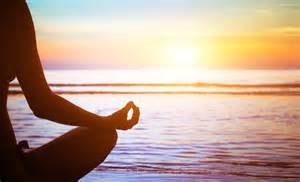 You have likely heard of meditation and mindfulness, or perhaps you have tried meditation before but didn’t stick with it. Meditation has been practiced by various cultures around the world for thousands of years. Even though the origin of meditation was spiritual in nature, a spiritual approach is not necessary for meditation to be effective. Meditation is an individual practice that is complimentary with any existing belief system.
You have likely heard of meditation and mindfulness, or perhaps you have tried meditation before but didn’t stick with it. Meditation has been practiced by various cultures around the world for thousands of years. Even though the origin of meditation was spiritual in nature, a spiritual approach is not necessary for meditation to be effective. Meditation is an individual practice that is complimentary with any existing belief system.
One popular form of meditation in the west is “Mindfulness Based Stress Reduction” or MBSR. MBSR was developed in the late 1970s by Dr. Jon Kabat-Zinn at the University of Massachusetts Medical School, as a way of integrating Buddhist philosophy and meditation with Western psychology. Since then, extensive research has been done on the effectiveness of mindfulness on stress, depression, anxiety, obsessive compulsive disorder, substance abuse, pain and chronic illness among patients and caregivers.
A recent literature review from the Journal of the American Medical Association has shown that in as little as 2.5 hours per week, the benefits of a regular meditation practice on depression are equally effective as taking an antidepressant. In addition, a study on Mindfulness Based Cancer Recovery found that with regular mindfulness meditation, patients in active treatment felt more energy, improved mental clarity and improvement in sleep.
In order to understand the impact of meditation, it is helpful to understand the body’s “Fight/Flight” stress response. The “Fight/Flight” response includes increased heart rate, blood pressure and stress hormones, shallow breathing and decreased immunity. The surge of hormones released during the “Fight/Flight” response is designed to be adaptive to a perceived threat and return to baseline when the threat goes away. Unfortunately, for many of us in our modern, busy world, the stress response remains activated, which may lead to chronic stress and illness over time. Regular meditation practice helps normalize the physiological effects of the “Fight/Flight” response.
There are many ways to begin a meditation practice. You may start by simply dedicating five minutes each day to sitting in a comfortable location, closing your eyes and observing the inhalations and exhalations of your breath. Seated meditation, conscious breathing, yoga and walking meditation are all considered “formal” practices that you may include during your daily routine. Mindfulness also includes “informal” approaches, which may carry through to all daily activities of living.
For further guidance, you may be helpful to take a class from a SDCRI affiliated meditation instructor. A meditation instructor can provide individual or group instruction to help you cultivate an on-going mindfulness and meditation practice promoting greater wellbeing and happiness.
SDCRI Affiliated Meditation Instructors:
• Erin Graves is a Clinical Social Worker and Chopra Center 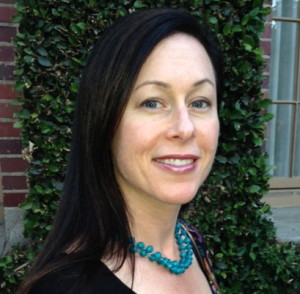 certified meditation instructor. Her areas of focus include meditation instruction and psychotherapy for wellness, anxiety, depression, adjustment to chronic illness, caregiver support and support to those in helping professions such as healthcare and education. Erin can be reached at: erin@anxietytraumatherapy.com or 619-272-6858×705.
certified meditation instructor. Her areas of focus include meditation instruction and psychotherapy for wellness, anxiety, depression, adjustment to chronic illness, caregiver support and support to those in helping professions such as healthcare and education. Erin can be reached at: erin@anxietytraumatherapy.com or 619-272-6858×705.
• Diana Shimkus, Licensed Clinical Social Worker offers a variety of Mindfulness Based Stress Reduction classes and programs in Encinitas at Everyday Mindfulness and may be reached at: www.everydaymind.com.
Recommended Reading:
• Mindfulness-Based Cancer Recovery by Carlson and Speca
• Wherever You Go, There You Are: Mindfulness Meditation in Everyday Life by Jon Kabat-Zinn
• The Book of Awakening: Having the Life You Want by Being Present to the Life You Have by Mark Nepo
• Zen Cancer Wisdom: Tips for Making Each Day Better by Suzanne Friedman
Unlocking the Mysteries of Oncology Massage
By Teri Polley-Michea MA, R.N., CMT, HHP
What comes to mind when you think of massage? A spa-like atmosphere, a warm massage table, scented oil, soft lighting, and relaxing music. Oncology massage can have all the same characteristics with one exception, your massage therapist should have additional training, both in the classroom and hands-on working with the person who has a cancer diagnosis and should hold a Certificate of Completion in Oncology Massage.
Webster’s dictionary defines massage as: manipulation of tissues (as by rubbing, kneading, or tapping) with the hand or an instrument for therapeutic purposes.
The Society of Oncology Massage, (S4OM.org) an organization that promotes ongoing education for massage therapists who are interested in providing massage to people with a cancer diagnosis, defines oncology massage as: “Oncology massage is the modification of existing massage therapy techniques in order to safely work with complications of cancer and cancer treatment. Anyone who has ever received cancer treatment, from those in active treatment to those in recovery or survivorship, as well as those at the end of life, are best served by a massage therapist who has received training in oncology massage”.
The word SAFELY should not be overlooked in this definition. Oncology massage therapists are trained to take an in-depth assessment prior to your massage. They are looking for signals that alert them so they can tailor the massage session to your current
state of health, not just your diagnosis. We are all individuals and what is right for one person may not be right for another and knowing the difference is what matters.
It is this SAFETY we focus on in oncology massage.
The session may seem very much like the way you remember from the past, only this time the Oncology massage therapist is working with your “new” normal self.
He or she has an awareness of your condition, whether present or past, keeping in mind your overall health picture. Not wanting to overtax your system, they modify your session to meet you where you are at today.
When I teach my class, “Massage Therapy for People Living with Cancer”‘ or even when I am addressing support groups, I stress to the audience, WE DO NOT EVEN KNOW WHAT WE DON’T KNOW. That is why is so important for massage
therapist to get additional training and for the consumer to interview their massage therapist. Find out what kind of training they have had. All Massage Programs are not alike. Does the Massage Therapist have a Certificate of Completion in Oncology Massage? What other types of experience do they have? How long was their training program? How long have they been a massage therapist? Are they licensed in the state and in the community you live? Were they referred to you by a trusted source?
Having a trained massage therapist may prevent an adverse outcome such as increased lymphedema or extreme soreness after the session. Not all outcomes can be prevented but someone with training and experience would be preferred than someone without the additional training.
Massage therapy has many benefits for the person undergoing treatment for cancer, and post treatment. Research has shown that massage can:
Decreases pain and muscular tension
Decreases nausea/ increases appetite
Stimulates bowel activity when working with peristalsis
Increased relaxation and promotion of sleep
Decreases fatigue
Enhances the immune system
Decreased cortisol (stress hormone) levels
Enhances mood – aids in the release of endorphins – feel good hormones
Reduces the feelings of isolation
Improves overall feeling of wellbeing
Improves self image/increases body awareness
Decreases anxiety
Increases mobility
Stimulates the nervous system
Moisturizes the skin, can decrease the chance of skin breakdown and irritation
Can improve peripheral neuropathy
Stimulates wound healing
Provides a distraction- gets the patient out of their heads and back into their bodies
Allows the patient to participate in their healing process by giving them an opportunity to talk about how they feel
Massage therapy soothes the body, quiets the mind and strengthens the spirit.
Plus massage feels good and YOU deserve to feel good!
If you have any questions regarding oncology massage please feel free to send me a email at jazmasu@sbcglobal.net or visit my website www.teripolleymassages.com
Exercise and Cancer Survivors
By Deborah Pomeranz
14 Million. This is the number of cancer survivors in the United States today. Each number represents a person who has stared directly into the face of cancer. In our corner of the world, the mecca of San Diego’s Coastal North County, we are fortunate to have North County Cancer Fitness (NCCF), a 501(c) (3) non-profit organization promoting strength and wellness for individuals who are newly diagnosed, undergoing treatment, or recovering from cancer. North County Cancer Fitness is dedicated to improving the quality of life for those affected by cancer through programs of fitness, education, referral and social connection. These services are available at no cost to those coping with cancer.
The word “exercise” can bring a collective groan when spoken in nearly any setting. However, among cancer survivors moving the body is a gateway on the path to feeling better. NCCF has learned that the ‘no pain, no gain’ philosophy does not fit in this arena. “Our bodies have been sliced, diced, patched, poisoned and burned. We can’t go back to the same level of physical activity as before we were diagnosed,” comments Deb Snyder, President and Founder of NCCF. However, a slow and steady approach to fitness interlaced with listening to the body has a positive outcome. During the last year NCCF has been privileged to be involved with Zumba for cancer patients, as well as a Gentle Fitness class at Fitness Evolution in Encinitas. Witnessing the range of individuals participating in these activities is gratifying and heart-warming. The kinship and comradery is as much a serotonin boost as is the physical movement!
The American College of Sports Medicine (ACSM) reinforces the recommendation that staying active during cancer treatment is beneficial. In addition, there have been numerous articles on the benefits of yoga while in cancer treatment/recovery reports the American Cancer Society (ACS). In general, people tend to have an increased sense of well-being with various forms of physical movement.
NCCF believes exercise is an essential component to cancer treatment and recovery. It is well documented that fitness increases the body’s ability to heal, encourages healthier lifestyles and reduces the risk of recurrence. NCCF creates individualized fitness programs that incorporate physical therapy, exercise classes, personal rehabilitation, nutritional guidance and mentorship. These elements are critical components for cancer recovery.
14 Million…and counting. North County Cancer Fitness encourages cancer survivors to keep putting one foot in front of the other!
Sound Healing
By Janet Motley
Sound Healing or Sound Therapy is not new. Many cultures, ancient and modern, have used sound for supporting the body and mind to heal itself. The use of sound for healing can be experienced in many forms. One is by means of the voice such as chanting, use of mantras, humming, or singing. Another is through the avenue of musical instruments such as Native American drums and rattles, clapping and dancing.
The duo sound healers, Janice Motley and Barbara Seymour, otherwise known as Bronze and Branch, have been performing sound meditation classes in San Diego North County for over 4 years with the use of percussion instruments, Tibetan singing bowls and the Aboriginal didgeridoo. The sounds and vibrations of these sacred instruments, along with the intention of healing that Janice and Barbara bring while playing, relaxes the body and mind. The delicate and transcendent, sounds they create helps to calm the nervous system. When the body is in a state of relaxation it has an opportunity to recover, repair and bring itself back into balance even down to the cellular level. This is beneficial for everyone but especially for individuals who deal with chronic pain, insomnia, depression and even cancer.
The harmonic sounds and vibrations produced by these instruments are powerful and safe. The dynamic sounds can enhance everyday life experience by improving concentration, reducing blood pressure, heightening perception and intuition, increasing energy and creativity, and even reduce side effects of chemotherapy. At the end of a sound healing session most individuals report feelings of calmness and peacefulness.
The unique sound healing experience with Bronze and Branch is like being bathed in a blanket of lullabies. One walks away feeling refreshed, energizing, self-confident and with a greater sense of purpose and appreciation for your life. It’s a wonderful way of honoring yourself with an inward journey of nourishment, serenity and renewal.
About Janice and the musical duo: Bronze and Branch
What Is Healing
By Shamini Jain
This talk was given at a local TEDx event, “Are you your own healer?” asks Dr. Shamini Jain. She invites us to discover the hidden possibilities of healing from a scientific and spiritual point of view.
“What is healing?” – Dr. Shamini Jain on TEDxOrangeCoast, Sept 2014
Dr. Shamini Jain is a psychologist, scientist and social entrepreneur. Dr. Jain is an Assistant Professor in the Department of Psychiatry at UC San Diego, where she is also Chair of the Center for Integrative Medicine’s Research Committee. She is also the Founder and Director of the Consciousness and Healing Initiative (CHI), a collaborative effort that links scientists, practitioners, entrepreneurs and educators to facilitate healing through an understanding of consciousness and consciousness-based practices.
Follow CHI, Consciousness and Healing Initiative, on Facebook.
Energetc Bodywork and Reiki
By Todd Sargeant
Energetic Bodywork
The knowledge that an unseen energy flows through all living things and is connected directly to the quality of health has been acknowledged, studied, and documented by cultures and societies around the world. Many systems of health and wellness have been developed around this vital energy and incorporate techniques and practices to keep it flowing properly throughout the body. It is understood on a very basic level that when this life-force energy becomes blocked, stagnant, deficient or even excessive, imbalance arises in the body which can lead to problems with the longevity and quality of life. There are may names for this energy. In the Chinese culture it is called Chi (Chee) as in Tai Chi. In Japan it is called Ki (Kee) like in Aikido. In India it is Prana (Prah-nah). In Hawai’i they call it Mana (Mah-nah). In Egypt it is called Seichim (Say-keem). In Sanskrit it is referred to as Shakti (Shock-tee). In the ancient culture of the Essenes it was called Life-force. And, the list goes on. Scientific experimentation has verified the existence of this life-force energy and scientists refer to it as Bio-plasma or Bio-energy. The scientific community continues to conduct experiments with this energy and is further examining the important role it plays in the functioning of the immune system and the healing process.
Energetic Bodywork facilitates the optimal flow of life-force energy through the many energetic centers, channels and pathways that are within the human being. The therapist makes use of safe, natural, and effective techniques from recognized systems of energy-work known around the world. The practitioners of these powerful healing techniques, as well as modern science, understand that humans are essentially organized matrices of different expressions of energy. These various levels of energetic expression act as waves or particles in relation to gravity and electromagnetism that operate within the aspects of a unified and/or quantum field. In other words; we see, feel, and interpret the life-force energy functioning throughout the universe in the capacities of light, sound, and matter.
Energetic bodywork allows the recipient to access all aspects of these energies, including energies that are beyond the electro-magnetic spectrum, at the foundation of their expression within the body. The treatment provider serves to support the recipient in their re-alignment of these energies for optimal flow and function. The recipient is not viewed as someone to be fixed, but a being to be returned to harmony and balance. It is important to note here that the practitioner does not heal but is the facilitator for the healing. Forms of energetic bodywork can be applied with the hands on the body, off the body, or even at great distances. What sets many forms of energetic bodywork apart from other forms of bodywork is that the recipient can remain fully clothed for the process. Energetic Bodywork incorporates a high level of awareness, a deep level of understanding, and a proper level of intention. These forms of treatment have been used throughout millennia to restore balance and enhance the quality and longevity of life. The integration and harmony produced by this process have been shown to revitalize, relax, increase clarity and awareness, relieve bodily congestion, minimize pain and enhance function and promote healing on all levels.
Reiki
Reiki (pronounced Ray-Key) is a Japanese term made up of two Kanji, or symbols. The first symbol, Rei, translates to mean universal, and refers to spiritual wisdom or spiritual consciousness. The second symbol, Ki, refers to the vital life-force that flows through and surrounds all things. Reiki, therefore, translates to mean universal life-force energy. Reiki is a safe, gentle, and natural method of connecting to life-force energy to facilitate healing and self-improvement that everyone can make use of and benefit from.
Reiki is garnering more and more attention for it’s effectiveness as a powerful yet gentle complementary therapy in integrative medicine. Once someone has learned the techniques of Reiki they can use it as a self-treatment or it can be offered to another. When a Reiki practitioner places his/her hands on (or around) an area of their own or a client’s body, Reiki flows through the provider and it is then facilitated to the recipient. If the recipient gives permission, the energy is then transferred from the practitioner to the client. This transfer may be felt as any type of sensation—heat, cold, vibration, tingling, unusual heaviness, or sometimes as no sensation at all. More often than not, a treatment feels like a wonderful glowing radiance that flows through and surrounds you. A full Reiki treatment takes about 60 to 90 minutes and many have stated that they feel revitalized and newly awakened after a session. Reiki heals by flowing through the affected parts of the energy field and charging them with vital life-force energy. It raises the vibratory level of the energy field in and around the physical body where self-limiting thoughts, unresolved feelings, and unbalanced energies are creating interference patterns with the flow of energy. This causes the non-serving energies to break apart, fall away, and/or re-integrate at a higher, more beneficial vibration. In so doing, Reiki clears, aligns, and heals the energy pathways, thus allowing the life force to flow in a healthy, natural, and optimal way. Because Reiki is guided by the higher wisdom of a universal and spiritual consciousness, it can never do harm, and because it is a channeled healing, the Reiki practitioner’s energies are never depleted. It always knows what a person needs and will adjust itself to create the effect that is most appropriate for them. One never needs worry about whether to give Reiki or not. It is always helpful. Reiki has specifically been documented to relax muscles, still the mind, and ease pain. Hands-on treatment has been shown to accelerate the healing process and many health professionals are incorporating the use of Reiki into their individual practices.
Reiki is an amazingly simple technique to learn. The ability to align with and utilize the energy is not taught in the usual sense, but is facilitated by and empowered within the student through the Reiki Master in an initiation and information process called an attunement. The use of Reiki is not dependent on one’s intellectual capacity or spiritual development and, therefore, is available to everyone. It has been successfully taught to thousands of people of all ages and backgrounds.
Numerous programs incorporating Reiki have been created for cancer patients, those with HIV, AIDS patients, those with PTSD, victims of war, and hospice care settings, to name just a few. Reiki treats the whole person, including the body, mind, emotions, and spirit. Reiki facilitates many beneficial effects including relaxation and deep feelings of peace, security, and well-being. Many have reported miraculous results. In its long history of use it has aided in healing virtually every known illness and injury including serious problems like: cancer, lupus, multiple sclerosis, and heart disease as well as skin problems, cuts, bruises, broken bones, headache, colds, flu, sore throat, sunburn, fatigue, insomnia, impotence, poor memory, lack of confidence, etc… Recently, many organizations and professional athletes have recognized the benefits of Reiki and are utilizing it to enhance physical and mental performance, increase energy, reduce stress, and help create optimism.
Clients who have received Reiki state that a treatment feels like a wonderful glowing radiance that flows through and surrounds them. Among the many thousands of Reiki practitioners all over the world, most will agree that “universal life-force energy” is only a minimal description of Reiki’s extraordinary power.
PhotoPainting
By Alessandra Colfi
June 18 – July 23, 2010
Introduction
In conjunction with a research study focused on resilience in cancer patients and caregivers lead by Dr. Paul Brenner, MD, Ph.D. at San Diego Cancer Center and Research Institute – SDCC / SDCRI – in Encinitas, patients and caregivers have been offered the opportunity to look at their experiences through the lens of a camera and to express them in a new and potentially insightful visual story format by adding paint, texture and collage in a mixed-media expressive art therapy process called PhotoPainting.
PhotoPainting is offered in cycles of 6 weekly sessions, several times a year; the first pilot program started Friday, June 18, 2010 and ended Friday July 23, 2010. The program is free and includes all art materials and disposable cameras; participation has been limited to 12 people with reservations. At any given session, 6 to 10 participants showed up.
The PhotoPainting series is facilitated by Alessandra Colfi, Ph.D., Expressive Arts Therapist, and was co-created with Mary Hollander, R.N., and Paul Brenner, M.D., Ph.D.
PhotoPainting provides participants with the opportunity to tell their stories as they unfold through images, while they integrate them as a symbolic reflection and transformation of their healing journey. The PhotoPainting Playshop is designed as a process of exploration, celebration, creativity, and healing; it will be followed up with short and long-term evaluations and new sessions throughout the year.
Goals & Objectives
The purpose of engaging cancer patients and caregivers in the PhotoPainting – Expressive Arts Therapy sessions is to assess and evaluate individuals’ resilience, their ability to access their inner resources and cope with challenges; it also surveys any change occurring as a result of participating in the processes of working with feelings and events related to their experiences with cancer, through pictures, symbols and hands on painting.
The assumption is that the human psyche – or soul – needs to express itself in order to stay or become healthy, and being in support of the mind and body throughout life’s experiences. The Expressive Arts Therapy processes offered within the PhotoPainting format are designed to facilitate and allow for a non-threatening approach to self-expression and exploration; they are grounded in Jungian psychotherapy and in the patient-centered approach which aim at facilitating the unconscious to emerge and become a useful ally to each individual.
Participants have been engaged in simple processes of self-reflection and in transforming their internal dialogue into images and potentially forming new associations and connections; also, the visual and tactile experience facilitates reaching deeper into the unconscious and intuitive wisdom to potentially gain awareness, guidance, acceptance and inner peace.
The PhotoPainting process has generated a series of collages and paintings as a result of each session being designed to build up methods and skills, as well to create a welcoming space and opportunity to share; the culmination is a mixed-media painting made by each participant, incorporating their own photographs, painting layers of rich colors and interesting textures. A CD with images and video clips is included here.
Participants are engaged with ease and playfulness, stating clearly about the importance of their enjoyment and being engaged in a meaningful process, above any expectation of result or outcome. As stated and practiced in all Expressive Arts Therapy sessions, relieving stress and providing a meaningful and playful opportunity for self-expression or to provide a much needed respite is always our priority.
A local newspaper, the North County Times, published an article following up direct observations by a reporter and a photographer during one of the sessions. There is a coordinated effort in the works for a collective exhibition of the PhotoPainting artwork at the Encinitas Library, as well as at the Front Porch Gallery in Carlsbad, with the scope of increasing awareness and recognition of SDCC / SDCRI integrative and comprehensive care model and of providing an opportunity for our patients to be directly involved in such endeavor, engage family and friends and the larger community, as well as to keep supporting their healing process.
Methods
All participants were asked to participate in a 6-session series, and at the same time were given them the flexibility to miss 1 or 2 sessions; this provision takes into the account that cancer patients might not feel well on any given day or they might undergo treatment or testing in a different location at the same time our session occurs. Also survivors and caregivers might at times need to attend other commitments. Patients undergoing treatment at SDCC were always able to join in the activities and accommodations were made to facilitate their participation.
At the start of every session, all collages/paintings were displayed on the wall for everyone to surround themselves with their artwork and meaningful images, like being in their “art studio”, and for spontaneous comments to emerge. Participants were always invited to share their thoughts and to ask questions.
1st session – Welcome and Introduction
At the very beginning participants were welcomed and an informal sharing of information took place; they were ask to complete a self-assessment form focusing on surveying their resilience; in addition, all participants were asked to read and sign an informed consent form and provide personal contact info; also a release form for any picture or video taken during the sessions.
Once all these were completed, we started the process of collecting personal statements and interests; I gave a general explanation of what was going to happen during the session. The main concern in this type of group settings is to establish an atmosphere of safety and non-judgment, in order to allow freedom of expression and the best possible outcome for the participants. Moreover, in order to help participants staying ‘in the moment’ and just focusing on the tasks at hand, very little information was given as far as planning ahead, what was going to happen next, etc. This is intended to facilitate spontaneity and intuitive association. This approach works when participants have a certain degree of trust and confidence in the facilitator; in this case, it can be attributed to the fact that several of the same patients have been participating to my Expressive Arts Therapy sessions for about a year and were familiar with my approach and methods used.
All participants were invited first to familiarize themselves with making an intuitive magazine photo collage, by selecting 5 to 10 images they felt intuitively attracted to or somewhat uncomfortable with, from a random pool, without asking themselves why they liked them or not, or how they would fit with one another. Some participants had to be encouraged to pick out a few more images, while others dove in collecting as many as they could.
Participants chose a colored paper background to start arranging their images on, getting used to the more ‘hands-on’ tearing of the edges instead of cutting them, overlapping some of them, leaving space in between or covering the whole surface… all feedback and exchanges were visual and intuitive; questions for reflection and to facilitate the process of ‘telling a story’ as it appeared in front of them were offered. Some participants showed a specific intention in creating a story; some were open to let their story unfold.
All collages were displayed for the whole group to see and make comment on. Each participant was encouraged and prompted to reflect and ‘stay’ with their collages, in order to establish an open dialog with it, exchange questions and remarks with the images.
For example, one patient picked an image of a snowman looking sad and melting while sitting on a bench – she said she had no idea why she picked this one and what to read in it – a few minutes later, she had glued the image of the sun – either setting or dawning – over the earth’s curved surface, overlapping and a bit imposing over the snow man.
She said she felt in awe about the universe, and I suggested to further inquire about her feelings and the relationship between the snowman and the ‘cosmic’ image. A little time went by; I came back around, offered hints, made suggestions… she did notice a feeling of powerlessness, and at the same time ‘melting of the old self’, ‘letting go’ and hope given by the sunrise –in a way this is the beginning of her new life.
I feel it’s empowering for participants to come to their own insights, to stay with their own questions, as opposed to offer a reading. My role is to offer support, questions to help them continue their self-reflection and feedback for the participants to find their own answers.
At the end of the session each participant was given a disposable camera and invited to take pictures of what was meaningful, attractive and potentially supportive of them, and/or challenging or uncomfortable, during their healing journey. It was explained to them they had total control of what they were going to photograph and when. For their convenience, I would receive all the cameras back by the 4th session, so I would take care of processing their photos and making copies of each one and bring them at the 5th session. On the 5th session they would start selecting and playing with the layout; when they felt ready, they would glue the pictures and paint on their canvas, to integrate them into ‘their story’; then continue painting at the last session.
From now on, all participants were encouraged to display their work at home or at least keep their work where they could see it many times during the week.
2nd session – Introduction to Universal Symbols & Demo
Symbols are all around us and inside of us; we unconsciously and/or consciously notice them and use them in our lives… this is a ‘taste’ in learning how to notice them, use them consciously and make them our allies! The 5 universal shapes as explained by Angeles Arrien were used in a fun and insightful exercise. Consequently, participants were encouraged to keep those symbols in mind and use them in their PhotoPainting as they wish.
The second half of the session was dedicate to my demo of painting and texturing, while participants had practice sheets and materials available to become familiar with the paint and texturing techniques on their own. I feel this was the session that ‘hooked’ participants in wanting to learn this painting technique, keep exploring and come back for more!
3rd session – Demo & Practice
As we continued practicing the painting techniques, participants kept themselves engaged with exploring the materials and brainstorming ideas, which made for a very playful and bonding session.
4th Session: Putting it all Together
Participants were invited to start by collecting 5 to 6 magazine images according to the same criteria as they did the first time – no more this time! – and start tearing edges and playing with a layout that was pleasing to them, on a sheet of watercolor paper. After they were happy with the layout, we used this collage to practice layering paint and texturing to blend images into the painting, incorporating them and integrating them, as a symbolic process of the psyche integrating and making sense of life’s experiences.
Patients spent quite some time experimenting with the texturing techniques and learning the different painting effects.
5th & 6th Session – PhotoPainting in the Making
Several participants received and review their photos and photocopies; photocopies are better suited because of the thinner paper on which they are printed and because this eliminates the anxiety associated with using the original photos and risking ‘making mistakes’.
Everyone was given a canvas; individual guidance was offered as always, to process layout options and to monitor comments and feelings around their ‘real’ stories.
As the paintings started coming to life, so did friendships within the groups. Spontaneous sharing and new materials showed up as themes and images came into play.
Ideally 8 sessions instead of 6 would allow for ease and time to complete the process.
Results
The survey on resilience taken at the end of the last session compares with the one taken at the beginning of the first session with a slight upward raise towards increased resilience in most areas. The chosen numbers which represent how each participant feels in each instance show a very slight improvement, and in some cases, a higher jump especially in regards with anxiety; verbal comments and testimonials are all very enthusiastic. A few participants assessed themselves high on each resource scale, most rated themselves high in some areas and mid- to low in other areas. Confidence has improved; playing and creating together and staying focused on the joy in their lives and to one another gives them strength and motivation.
Most participants would like to continue these kinds of sessions and feel they would benefit from individual sessions as well. Not only they all enjoyed the PhotoPainting activity, but they feel strongly that it helped them in their experience with cancer.
Testimonials:
‘I enjoyed playing with the different things and feel proud of myself for what I have created so far’ ~ N.D., Poway
‘Thank you for everything! I am a new person when I get together with all of you. It really is a “pick me up!” ‘. ~ V.R. Encinitas, CA.
‘Enjoyed progression of artwork’ ~ I.G., Vista
‘Joy, healing and creative. Thank you!’. ~ N.K. Encinitas
‘Much needed – Opened new avenues I was hoping to find. It helps balance all my current experiences’ ~ K.K., Encinitas
‘I loved it and Alessandra too! It was something to look forward too!!’ ~ L.I., Carlsbad
‘I enjoyed the workshop. I knew I would! I was hoping it would stimulate to start my own projects and I already have.’ ~ V.C., Encinitas
Conclusion
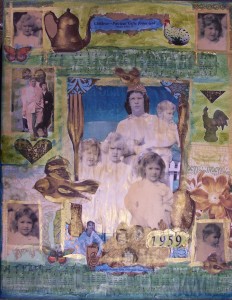 This project is but one snapshot within a continuum; there needs to be a discussion with the whole research team on patients’ resilience and how to support and foster it in them. Clearly, there is a role for Expressive Arts Therapy in the medical setting, especially in the oncology arena, as a supportive adjunct to the clinical care associated with the traditional medical model. The incorporation of EXT into a comprehensive cancer care program brings an increased sense of connection and well being among those patients in active treatment who chose to participate in the EXT therapeutic process. Some patients brought in a family member for a session; they also participated actively and were very supportive not only of their own relative but also of the other participants.
This project is but one snapshot within a continuum; there needs to be a discussion with the whole research team on patients’ resilience and how to support and foster it in them. Clearly, there is a role for Expressive Arts Therapy in the medical setting, especially in the oncology arena, as a supportive adjunct to the clinical care associated with the traditional medical model. The incorporation of EXT into a comprehensive cancer care program brings an increased sense of connection and well being among those patients in active treatment who chose to participate in the EXT therapeutic process. Some patients brought in a family member for a session; they also participated actively and were very supportive not only of their own relative but also of the other participants.
Since studies have suggested that an increased sense of patient well being often results in increased patient compliance and better clinical outcomes, incorporating Expressive Arts Therapy into the oncology medical setting makes sense from the standpoint of progressive, patient-centered program development.
Recommendations
Some of the patients missed a few sessions and some the last session for a variety of reasons; I would incorporate at least one individual session to close the process and allow each participant to dialog with their artwork and acknowledge what they accomplished and the meaning it has on a very personal level.
Many participants also stated that they would like a 3-hour session, since it takes them a while to get started and once they are ‘in the flow’ and immersed in it, they don’t feel like stopping – 2 hours flew by very quickly each time!
A couple of participants didn’t have their cameras ready for me to process their film and promised to have it done on their own – which didn’t happen. In order to accomplish this task, I would have had to meet with these patients separately and figure out the logistics to have everyone’s pictures ready by the following session. Besides, taking a bunch of pictures in a few days ‘just to do it’ didn’t fit the purpose of this process and didn’t feel very meaningful to me. The fine line between coaching/allowing for people to take responsibility and expecting them to comply can be discussed.
My recommendation is to continue offering series of sessions to patients in partnership with the medical research to survey their resilience to diagnosis and their improved response to medical treatments, stress management and overall quality of life, including work, personal interests and relationships.
‘The creative activity of imagination frees man from his bondage to the ‘nothing but’ and raises him to the status of one who plays. As Schiller says, man is completely human only when he is at play.’ ~ C.G. Jung
Resources
Detailed Assessment Forms and Resilience Survey Results are available upon request.
References
Arnheim, Rudolph: Visual Thinking, 2004
Arnheim, Rudolph: Art and Visual Perception: A Psychology of the Creative Eye, 2004
Arrien, Angeles: Signs of Life, The Five Universal Shapes and How to Use Them, 1992
Brune, Brigitte: Symbols of the Soul: Therapy and Guidance Through Fairy Tales, 1993
Connor, Kathryn M., M.D. and Davidson, Jonathan R.T., M.D.: Development of a new resilience scale: The Connor-Davidson resilience scale (CD-RISC), 2003.
Davy, Elisa: Doorways to the Soul: 52 Wisdom Tales from Around the World, 2007
Friborg, Oddgeir, Hjemdal, Odina , Rosenvinge, Jan H. , Martinussen. Monica: A new rating
scale for adult resilience: what are the central protective resources behind healthy
adjustment? International Journal of Methods Psychiatric Research, 2003; 12(2): 65-76.
Fredrickson BL, Joiner T.: Positive emotions trigger upward spirals toward emotional well-being, 2002.
Frost, Seena B.: SoulCollage: An Intuitive Collage Process for Individuals and Groups
Kaplan, Frances F. (editor): Art Therapy and Social Action, 2007
Jung, Carl Gustav: Man and His Symbols, 1964 Landgarten, Helen : Magazine Photo Collage, 1993
Samuels, Mike and Nancy: Seeing with the Mind’s Eye – The History, Techniques and Uses of Visualization, 1975
